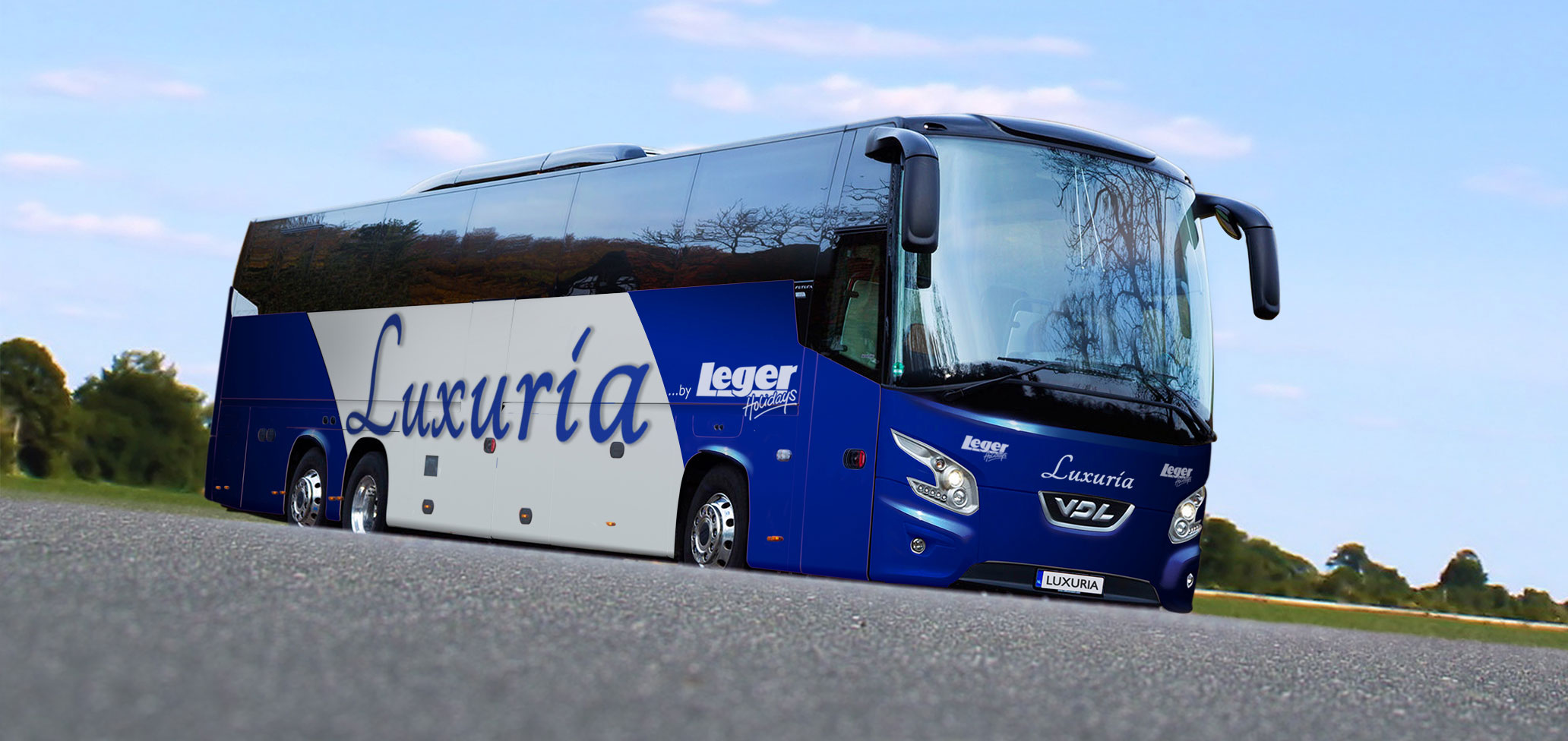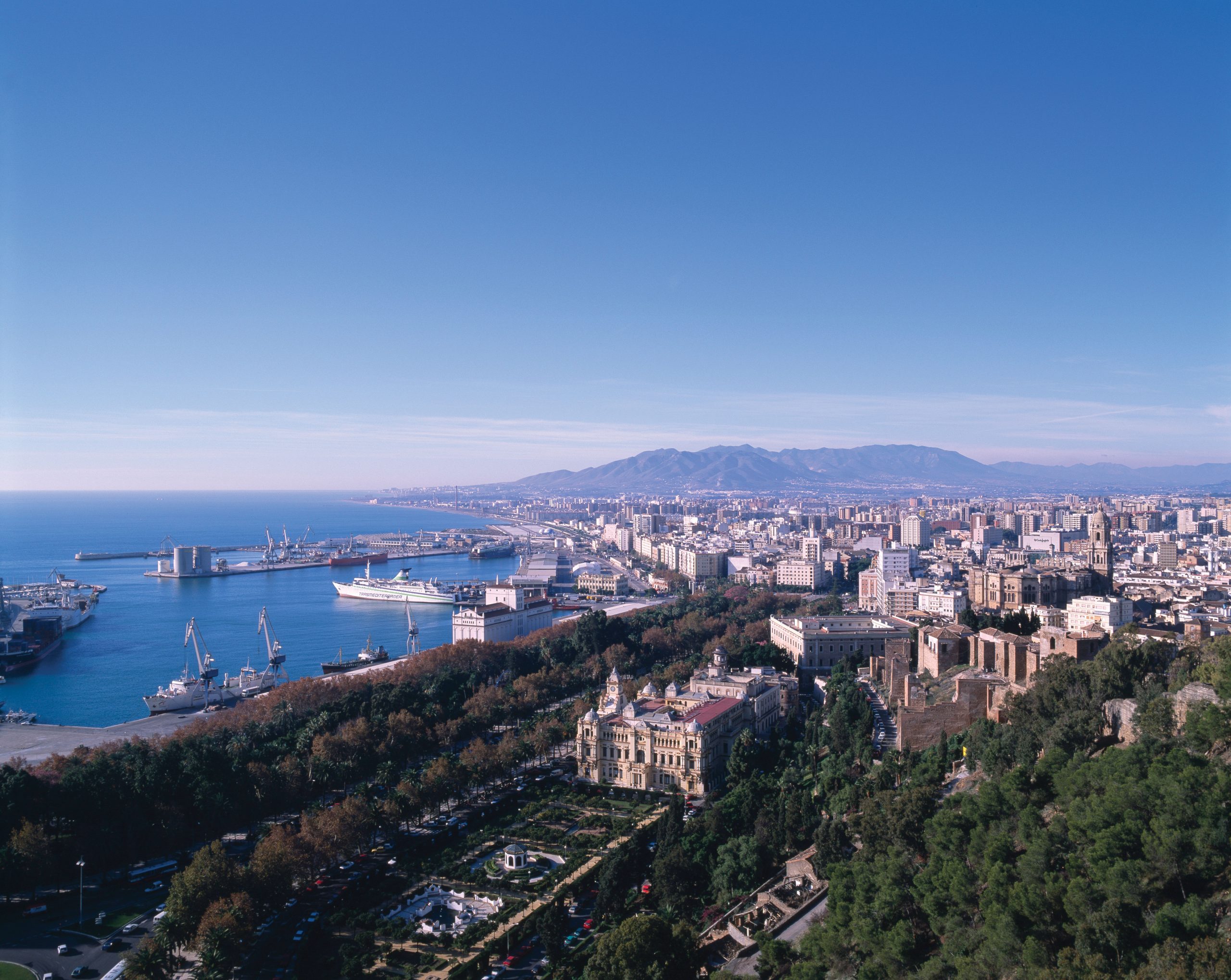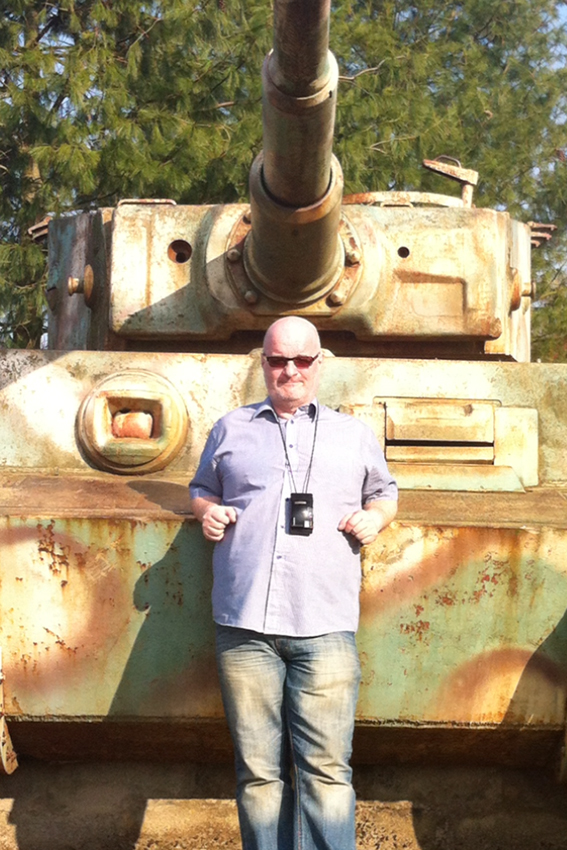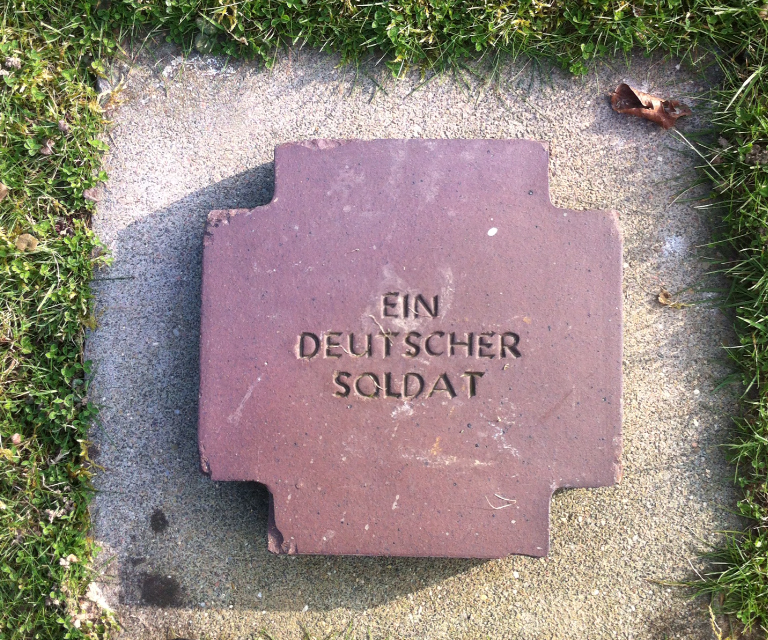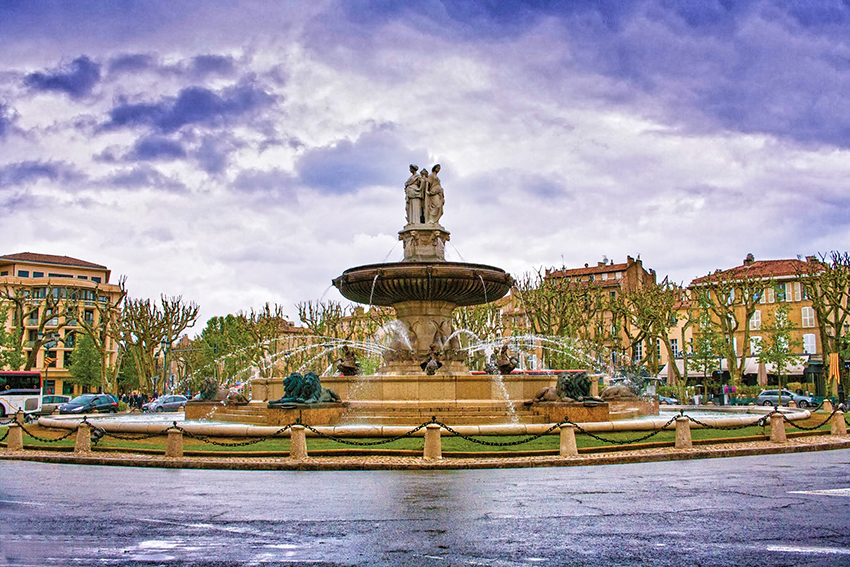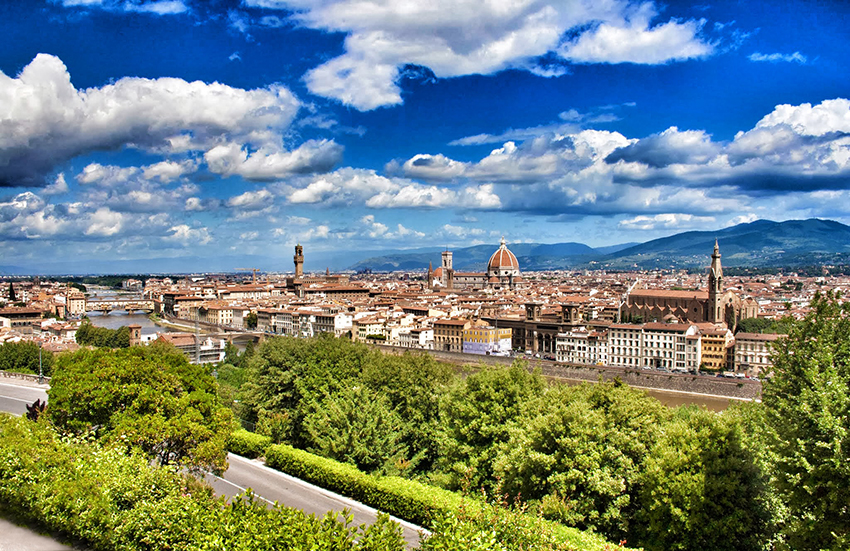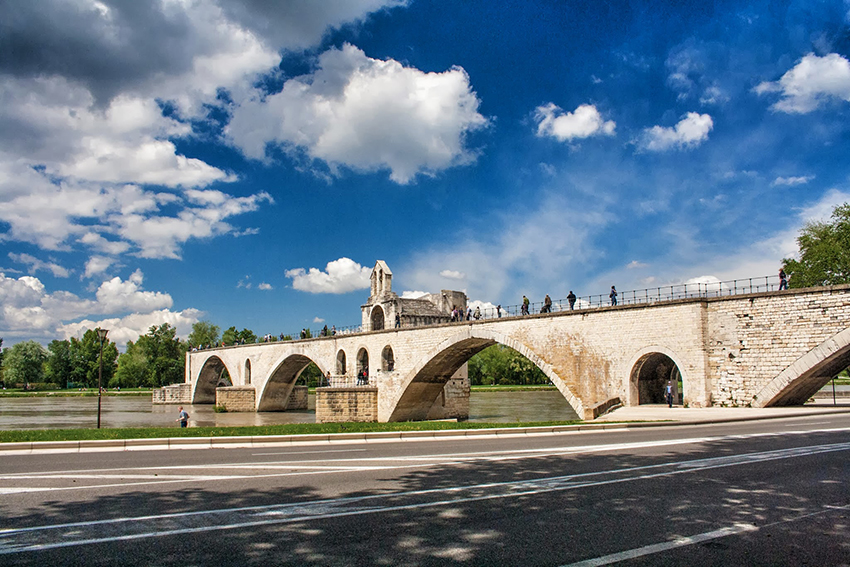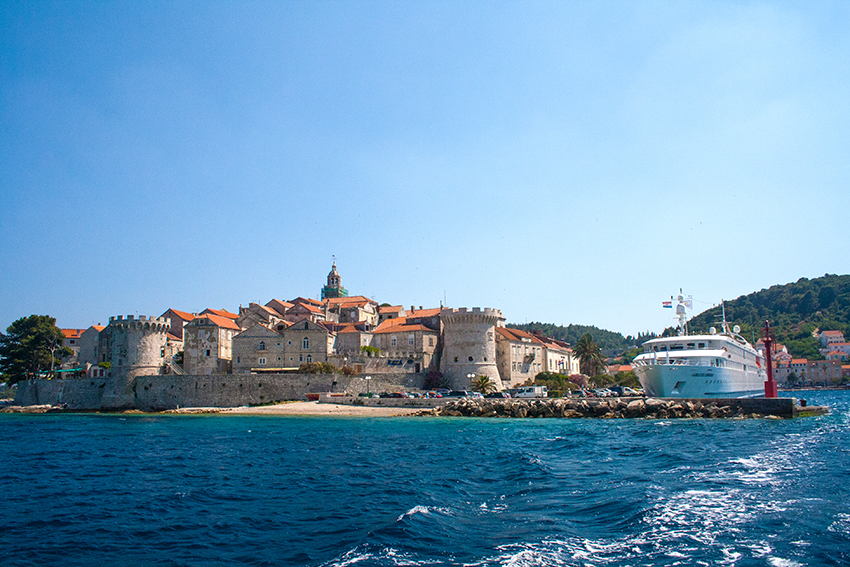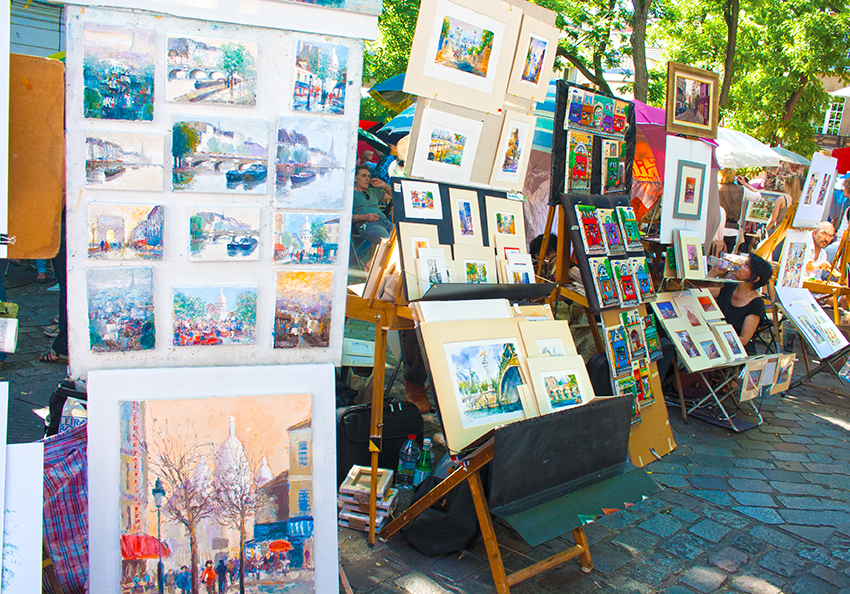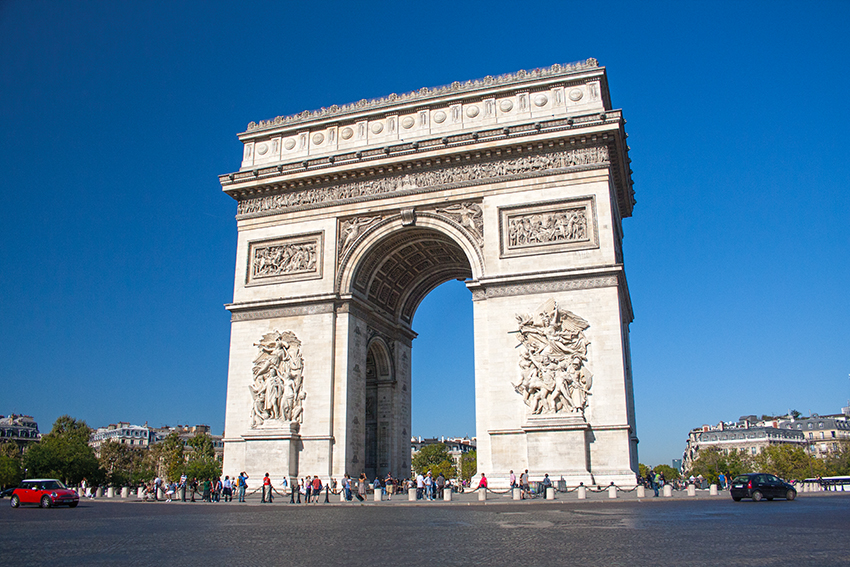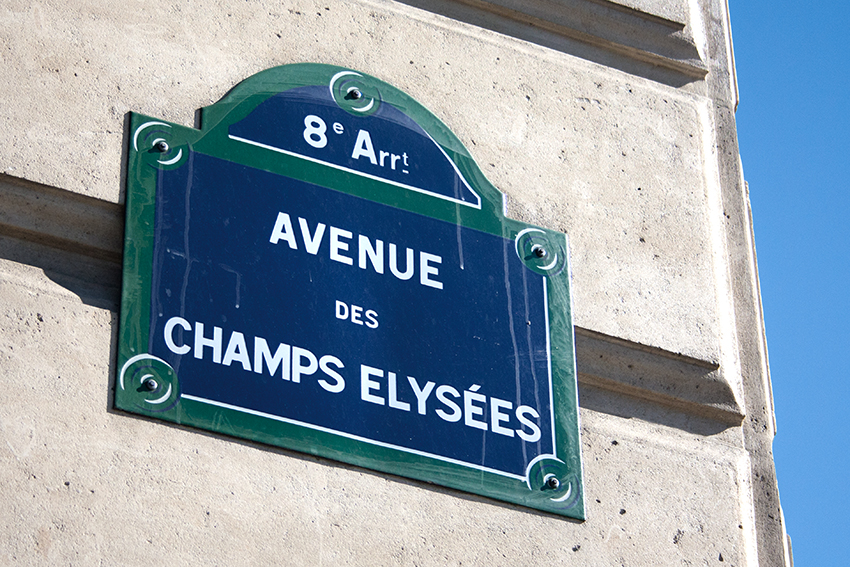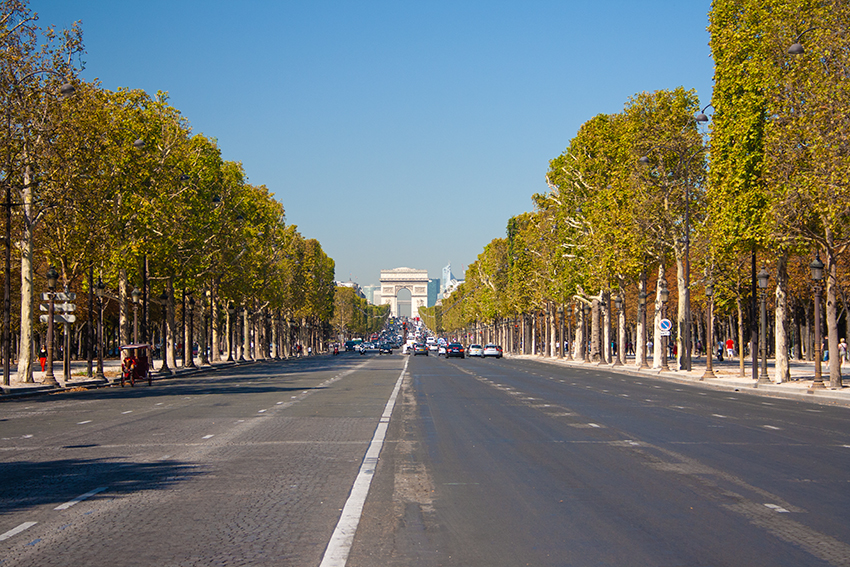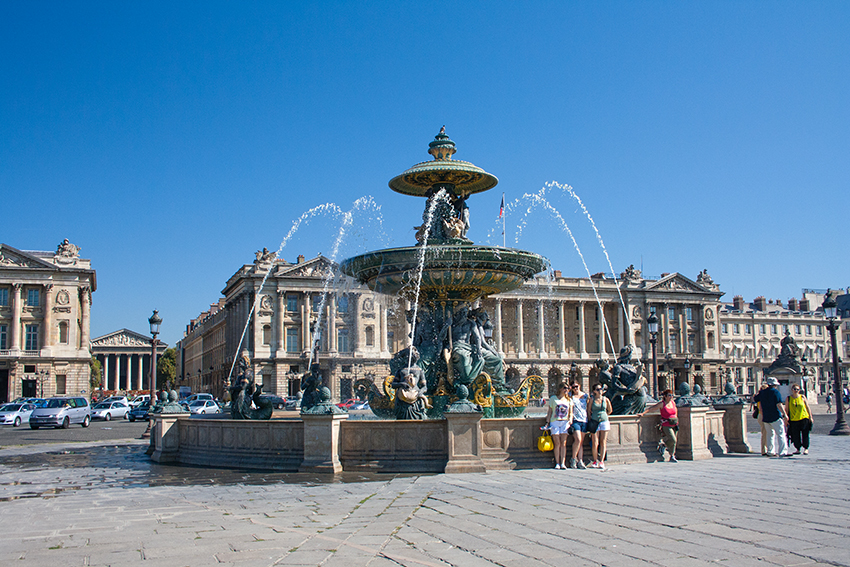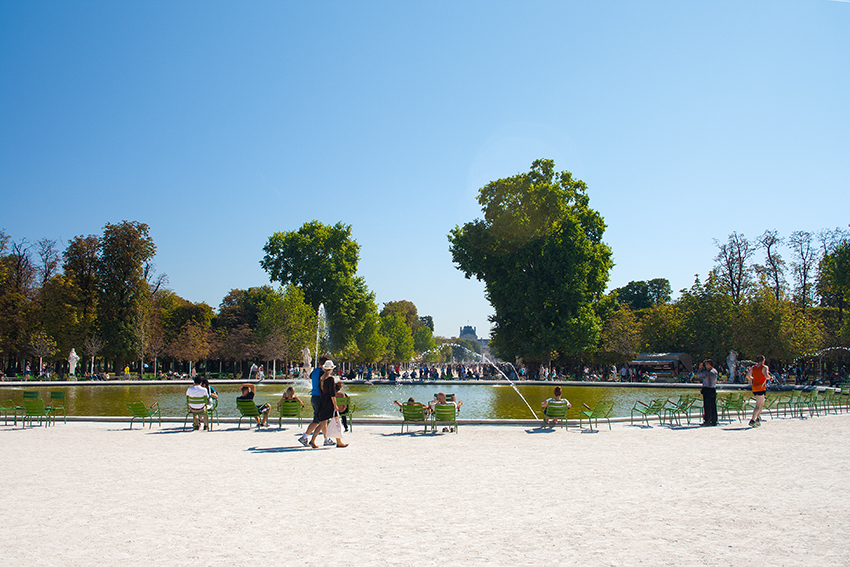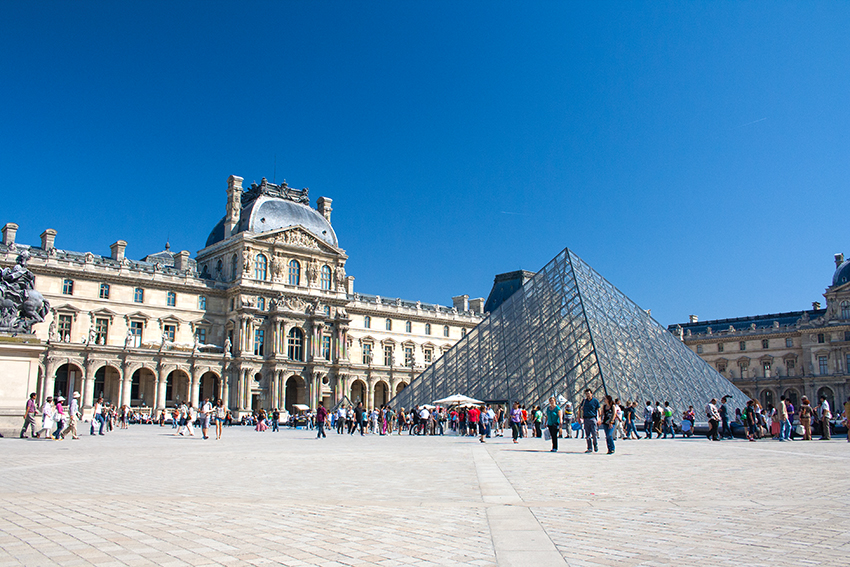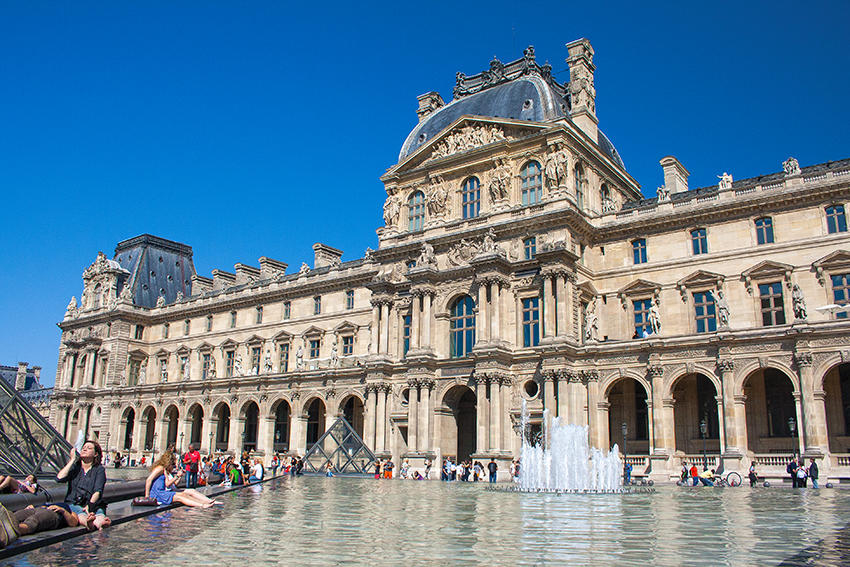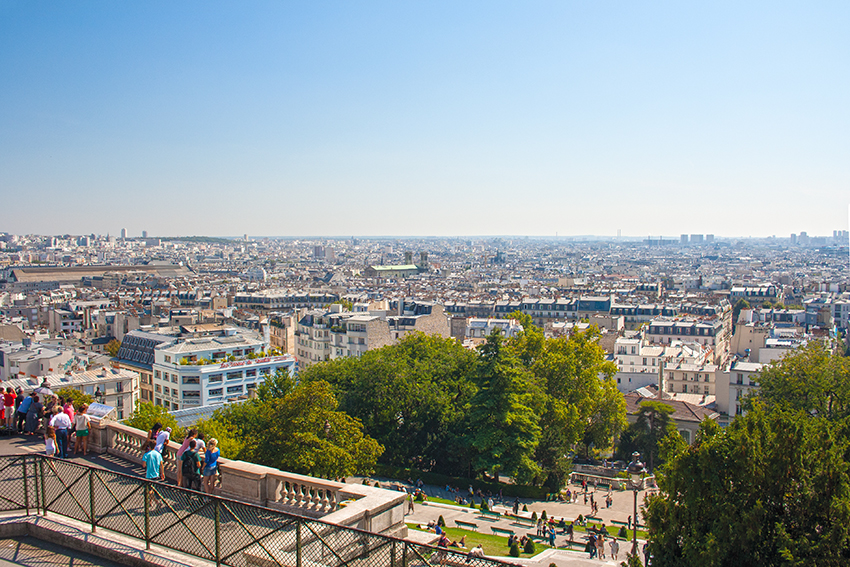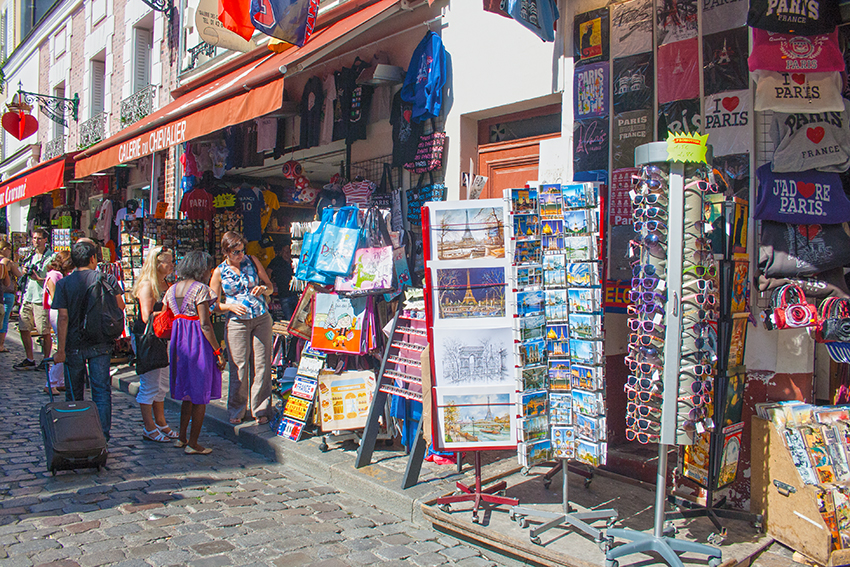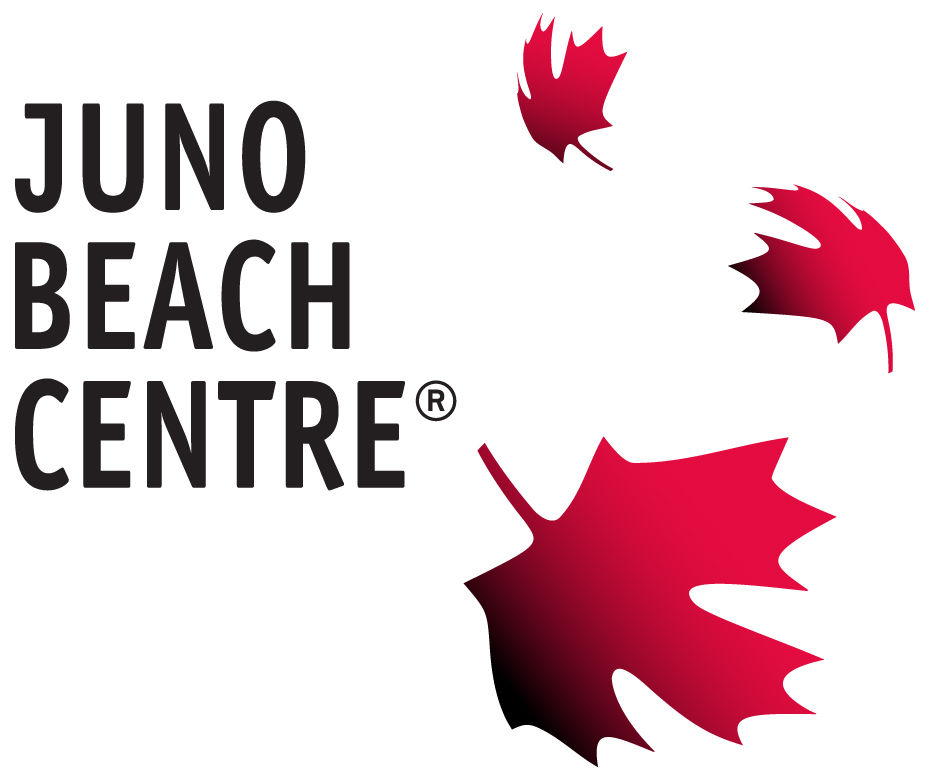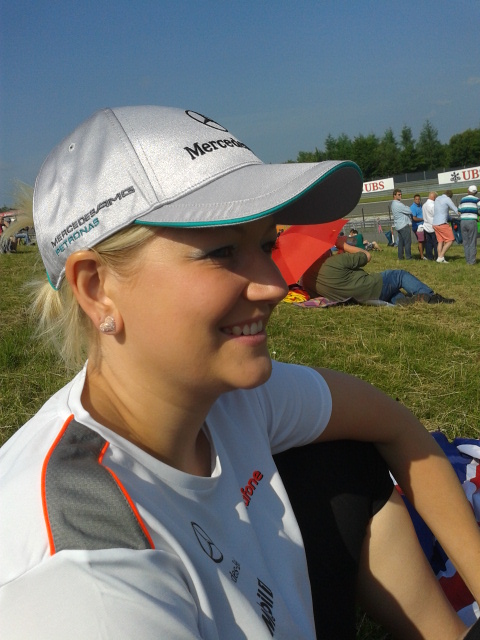Leger Holidays are proud to present our NEW and innovative Luxuria coach.
In 2003 when we first introduced Silver Service we set the standard for added comfort and style when travelling across Europe. Many of you have been asking “What next?”…the answer is Luxuria – the next level in escorted touring travel.
Luxuria takes coach travel to the next level of comfort, it only seats 31 passengers in rows of three, meaning significantly wider seats and extra leg room.
The deluxe armchair-style seats, some with tables, also feature retractable calf rests, fully-interactive personal touch screen TV’s, offering a wide choice of movies, T.V programmes and music so you can watch what you want when you want.
For added comfort there are cup holders along with USB and UK plug charging points. Refreshments are also available on board and porterage is offered at most hotels.

Another standout feature of Luxuria is the selection of double and single seats, including four seats face to face with tables. On each row there are just three seats rather than the usual four, meaning each armchair-style luxury seat is wider and with more personal space around it for a more comfortable journey. And with up to 7 single seats available, these are likely to be very popular with single travellers and those who enjoy their own personal space.
For more information regarding the new service and the tours Luxuria will feature on please visit our dedicated website page here.

Málaga: A Cultural Haven in Southern Europe
The first time I visited the capital of the south coast of Spain, Málaga, some 15 years ago, cultural enrichment wasn’t exactly on my mind. I’ll admit it; I did like many expats in this region and followed my heart (or my Andalusian boyfriend, in this case). The love affair didn’t last very long, but little did I know that it would lead to a far deeper and longer-lasting relationship with what has come to be the city of my dreams.
Most fist-time visitors to Málaga (or those who first move here) tend to spend endless weeks on the beach, toasting their skin to golden perfection and enjoying Málaga’s most famous delicacy: coal-barbecued sardines on a spit, cooked in a fire built in little wooden boats, which grace most of Málaga’s famed frontline restaurants, called chiringuitos. When it comes to chiringuitos, of course, the word ‘restaurant’ doesn’t quite fit; most are informal, meant to be frequented by sand-strewn holidaymakers. Chiringuitos are built on wooden decks, under thatched roofing, a few steps away from the beach. They are the perfect reason to stay seaside all day; whenever one feels parched or hungry, a cool sangria and plate of paella are just a stone’s throw away.
As one matures and the fear of skin cancer takes hold, , priorities begin to change. As what in our mind has always been a sleepy seaside tourist town becomes the place we live, work and build our family in, we seek a more profound connection to its natural landscape, history and culture. In many ways, my decision to live and make my life in Málaga in 1996 coincided with the transformation of this coastal capital into an impressive cultural hub.
If you are a traveller who likes to combine the very best of Nature, culture and shopping, Málaga is an ideal choice. This is a mountainous city, offering keen trekkers and mountain bikers alike a vertiginous experience. The mountains can be enjoyed by children, too; in Benalmádena, a 10-minute drive away from the capital, there is a fun cable car experience that takes you to the summit of one of the most expansive mountain ranges in the area. From above, you can view the beauty of the coastline and enjoy an amazing falconry show featuring wild eagles, hawks and the like. Following your descent, few things could be better than heading for the beach and enjoying a hearty lunch.
One of the best things about the South of Spain is how far your dollar or pound goes here. Many venues offer a three-course meal (including a glass of wine) for under £8, though if you’re after a gourmet experience, you should probably head for Marbella – 30-minute car ride from Málaga, Marbella is a famed destination for high-end residential tourism and it boasts everything the discerning travel could demand, including gourmet restaurants. For a true taste sensation, try two-Michelin-starred Chef, Dani GarcÃa’s new restaurants at the Puente Romano Hotel. The first of these, Dani GarcÃa Restaurant, offers an amazing tasting menu inspired on the world of fairytales. The second, Bibo, is a haven of gourmet tapas whipped up with revolutionary techniques, including the use of liquid nitrogen to ‘freeze’ sorbets that melt ever so slowly in the mouth. Marbella has its own Rodeo Drive on the luxurious port of Puerto Banús, with stores such as Louis Vuitton and Jimmy Choo attracting affluent shoppers from around the world. Budget travellers need not fear spending more than they can afford, however; if one’s focus is cultural rather than material, there are many museums and galleries to keep you occupied. Let’s whiz back to the city centre of Málaga, where you will find these treasures:
- The Málaga Car Museum: Launched in 2010, this museum is dedicated to art on wheels: keen motorists will find over 90 classic cars, hailing from the collection of avid car buff, Joao Manuel Magalhaes. www.museoautomovilmalaga.com
- The Carmen Thyssen Museum: Famed art collector, the Baroness Carmen Thyssen, ceded an extensive part of her impressive collection of 19th century Andalusian themed to the province of Málaga, to enable the opening of the Carmen Thyssen Museum. This is a great museum to visit in under an hour, since the collection is presented in such a way that it is very easy to appreciate the stylistic and thematic development of art in the 19th century. Early works are highly stylised at first, then progress into a more realistic style. Finally, the focus of the paintings is more on cosmopolitan subjects rather than regional ones. www.carmenthyssenmalaga.org/en
- The Glass and Crystal Museum: If you have just one day to visit a museum, let it be this one. Housed in an old Andalusian mansion in the very heart of the city, it contains the private collection of Cambridge scholar, Dr. Gonzalo Fernandez Prieto, who gives tours of his extensive collection in both English and Spanish. There are over 3,000 pieces to wow at, though what really makes the visit special is Fernandez Prieto’s wit and sheer passion for glass and crystal. Discover delightful historical facts, anecdotes and information about the ancient art of glass and crystal design and manufacture. www.museovidrioycristalmalaga.com/
- The Contemporary Art Centre: This museum is one of the most impressive in terms of size, since it contains a vast number of artworks from the 20th and 21st centuries and has housed exhibitions by some of the world’s most renowned artists, including Louise Bourgeois or Ron Mueck. www.cacmalaga.org
- The Picasso Museum of Málaga: Picasso is arguably Málaga’s famous son (alongside Antonio Banderas). View over 230 of the artist’s works, donated by his family. www.museopicassomalaga.org
- Last but not least, do pay a visit to the Cervantes Theatre, 19th century jewel which offers fantastic opera, dance and music performances. www.teatrocervantes.com. If you are travelling with kids, take them to a theatrical performance at the Teatro Echegaray. www.teatroechegaray.com
This post was written by Susie Collins
A battlefields tour and a journey to a 'free Europe'
Paul Prendergast shares his experience of the D-Day Landings in Normandy tour, his second Battlefields tour with Leger.
DAY 1
The first day of our Battlefields tour started with a noon pick up at Pease Pottage service station. It was a smooth journey down to Dover where we had the changeover onto our coach onward to the Battlefields of Normandy. Whilst at Dover I had the chance to have a quick chat with Paul Reed, the Leger Head Battlefields Guide – this man is without a doubt a great Military Historian and his knowledge is boundless. It was a real pleasure to meet him and shake his hand. We arrived in Calais with no problems. On the four-hour drive to the beaches of D-Day the journey was quick and pleasant and Mark and Dave – our drivers – were friendly, smart and willing to help. Our guide for the trip was Bill McQuade. He told us what to expect on each day of the tour. Again, his military knowledge was boundless and he answered any questions with no problems.
DAY 2
We set off at 08.30am to Pegasus Bridge. It was great to actually walk on the bridge – just to think, this was the point that the heroes started to fight to free Europe and get back the freedom to the people of France. We also went to visit the Gondrée Café which was the first place to be liberated in France. I found it quite remarkable that a small band of men risked so much on this bridge. We stopped for lunch at a small café just next to the bridge before going to Sword Beach – Queen’s sector. This is where the British landed. We also stopped to see a statue of a piper who led the soldiers into battle playing – this was at Hermanville which is twinned with Tangmere in West Sussex where a Battle of Brittan RAF squadron was based. We then visited the Juno Sector of the beach which is where the film D–Day was actually made and then went to see a memorial to the 7000 Canadians that landed on the beach, before moving on to the Juno Centre – a fantastic place to look around at pictures and artifacts. I sat in a small cinema with a small group of people from our group and also a group of children from Canada. The film showed actual battlefield dead and casualties, and as we left the cinema I found some of the children crying. I asked if they were OK and one of them told me that it had brought it home to them what really happened. I found it quite touching that children from today realise what these men gave up. We then visited an underground bunker which was in very good condition – it still had the small stove and cots in it. We then went to Mulberry B. We couldn’t see a lot due to the mist on the sea, and can only imagine how it was on 6th June 1944.
DAY 3
Our day began with a very misty drive down to Bloody Omaha, the American sector of the D-Day landings. We started our day at the American War Cemetery at Omaha. I have never visited any other cemeteries apart from the British ones and I didn’t know what to expect. On arrival there were immaculate white headstones as far as the eye could see. Buried in this place are a few people who I would like to mention: Robert A Niland, killed 06/06/44 and Preston Niland, killed 07/06/44 – two brothers killed within a day of each other and on whom the film Saving Private Ryan is based. Also, Theodore Roosevelt Jnr., killed 12/07/44, son of the American President.
Walking around this place bought chills to me and brought home the price that these men paid for my freedom today. Then it was on to the Overlord Museum. This had some fantastic pieces of kit in it to look at close up, ranging from a Panzer Tank to Sherman Tank and personal belongings of British and American soldiers. We then went down onto the actual Omaha Beach. I can’t imagine the mayhem and slaughter the Americans must have gone through on the landing day. I went up a small path which lead to a small German bunker which likely held a machine gun because of the vantage point down on to the beach. We then went to Utah Beach to a fantastic little place where you could have look around and actually see what happened on the day. My favourite part of Utah Beach was when I found a few German bunkers that you could actually go into. We then stopped at a statue of Dick Winters – he was one of the Band of Brothers. We stopped at a tribute to the 101 Airborne Division, otherwise known as Easy Company, made famous by a TV series by Stephen Spielberg.

The last trip of the day was to a German War Cemetery. I didn’t know how I would feel about this because I’ve never visited one before. It contained about 8000 soldiers of all ranks. What was also shown to me by our guide was the grave of Michael Wittmann and his tank crew. He was one of the most daring commanders of his time and he died and was buried with his crew. I walked around the cemetery and noticed no headstone standing upright and the lack of flowers on any graves. I asked Bill, our guide, why this was. He said it was that a ‘Spirit of the Forest’ approach is taken to death in Germany, hence the lack of flowers – only firs and ferns on some graves. In the British cemeteries, any soldier that is not known and buried is marked with the words ‘Known But To God’. Here nothing. All it said was Ein Deutscher Soldat – A German Soldier. I found it simple but quite touching. A very thought-provoking end to the day.
Day 4
We set off on another misty day to visit Jerusalem Cemetery, a very small place with only 48 buried at the cemetery. I found a grave of J Banks DLI who died on the 21st July 1914 aged just 16. How can a child die like that because he wanted to do the right thing for King and Country? We stopped to take some photographs of a memorial to the 49th West Riding Division and then onto the Scottish Corridor and Hill 112 to look at a Cromwell tank. Unfortunately, we couldn’t see much from the top of the hill due to the mist. We stopped off in a town called Falaise for lunch – this town is famous for being the town where William the Conqueror was conceived – before going to Mont Ormel, known as The Polish Battlefield. We also went to a small but fantastic museum which had great artifacts and also a fantastic view of where the German retreat took place. The group’s last stop was at a National French monument which is a tiger tank abandoned by its crew. We had a group photo taken by Bill.
The thoughts on my first Leger WW2 trip? Simply fantastic. Our guide, Bill McQuade’s knowledge was amazing and all our questions were answered. His passion for his subject is simply wonderful. Our drivers, Mark and Dave were safe drivers, always helpful and well turned out. With the 70th anniversary of D-Day fast approaching, I would recommend this trip without a doubt.
This was my second trip with Leger in under six months – my first was All Quiet on the Western Front – and I’ve enjoyed them both. Which one next? Verdun? Fritz? Tommy? Who knows, but whichever one I book, I know it will be great.
Lose yourself in Cézanne ’s home town.
Known for its many fountains, famous artists and impressive architecture, next stop on my tour of Provence and the Dordogne was the charming town of Aix en Provence.
It was raining heavily as I stepped onto the streets of Aix en Provence, a town no stranger to water being known as the ‘City of a Thousand Fountains’, the water coming from the city’s underground springs. One of the first things I saw was… a fountain: the fountain of La Rotonde to be exact, built in 1860, and a sight I spotted on many postcards throughout my visit. As I walked along the street, following my map in the direction of a street named ‘Cours Mirabeau’, people dashed around shielding from the weather under brightly-coloured umbrellas or were sheltering in doorways or in the haven of one of the cosy cafés. I passed one old lady wearing a carrier bag on her head – stylishly, of course, it was the south of France afterall. She’d obviously not anticipated such a heavy downpour today.
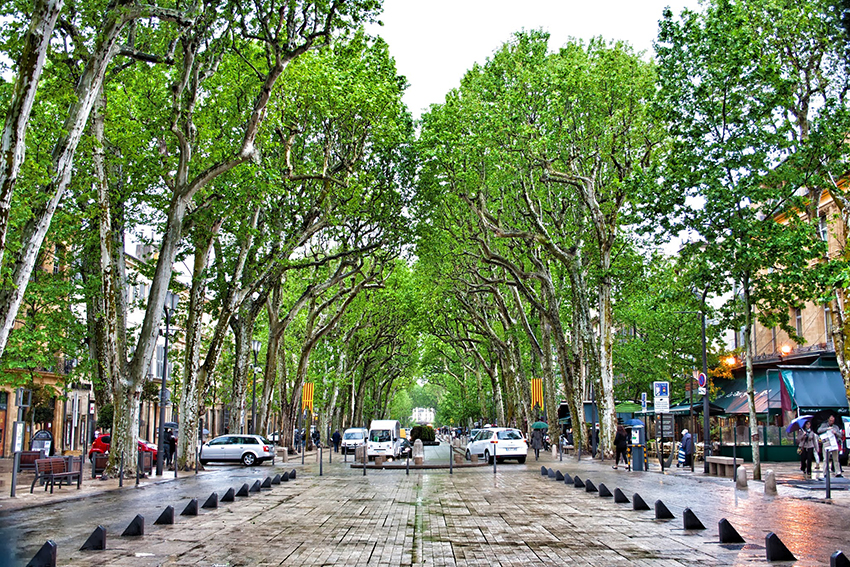
After a couple of minutes I reached the wide avenue of Cours Mirabeau. One the right-hand side, banks and other businesses filled the old buildings, while to my left, inviting cafés, book stores and gift shops lined the street. Continuing along, I came across one of Aix’s thousand fountains: a moss-covered font known as the Fontaine des Neuf Canons (the Fountain of the Nine Cannons), apparently located on the site of a spring where sheep were once brought to drink while migrating. Further along, I spotted another mass of thick, green moss hiding another fountain known as the ‘mossy fountain’ – the Fontaine Moussue, a thermal fountain whose water comes from a hot natural spring.
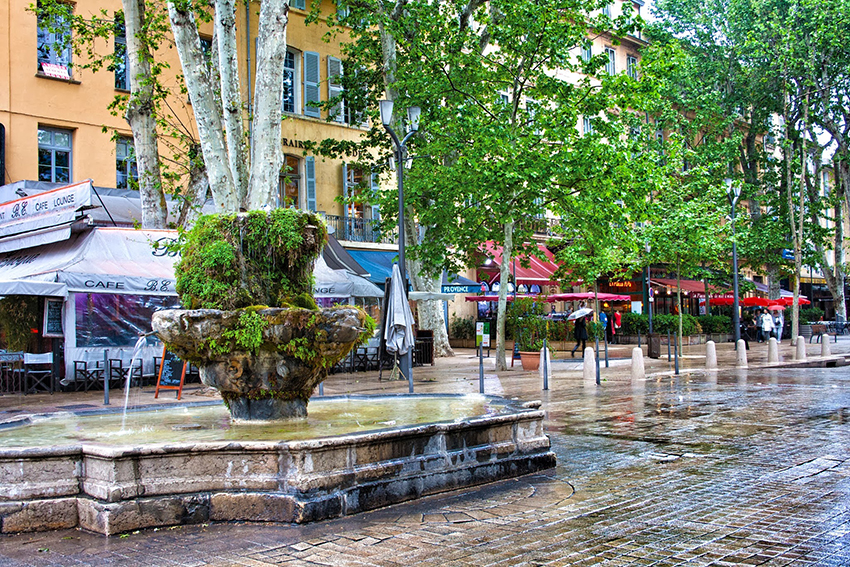
The reflection of car headlights danced across the wet, glossy pavement as I carried on along the avenue, framed by huge sycamore trees (or plane trees as they’re sometimes referred to), and there on the left was a café called Les Deux Garçons. I’d read about this place before my trip, and knew it as the legendary brasserie frequented by the likes of Edith Piaf, Ernest Hemmingway, Winston Churchill, Paul Cézanne and his friend, novelist Émile Zola. It was in fact here in Aix en Provence that the great painter Paul Cézanne was born in 1839. It was a name I remembered from my Art History studies, many years ago, and as I walked along, on the pavements I noticed small brass medallions underfoot which displayed his name and a large letter ‘C’. These plaques mark around 30 significant places associated with the painter’s life, making up the ‘Cézanne Trail’ which starts at the bronze statue of Cézanne standing just outside the Tourist Office and opposite the Fontaine de la Rotonde. The statue was put there in 2006 marking the centenary of the artist’s death. The trail features sites such as the College Mignet (then known as Bourbon College) which is where Cézanne met Zola; the building where Cézanne was born and, of course, the Café des Deux Garçons at No. 53 Cours Mirabeau.
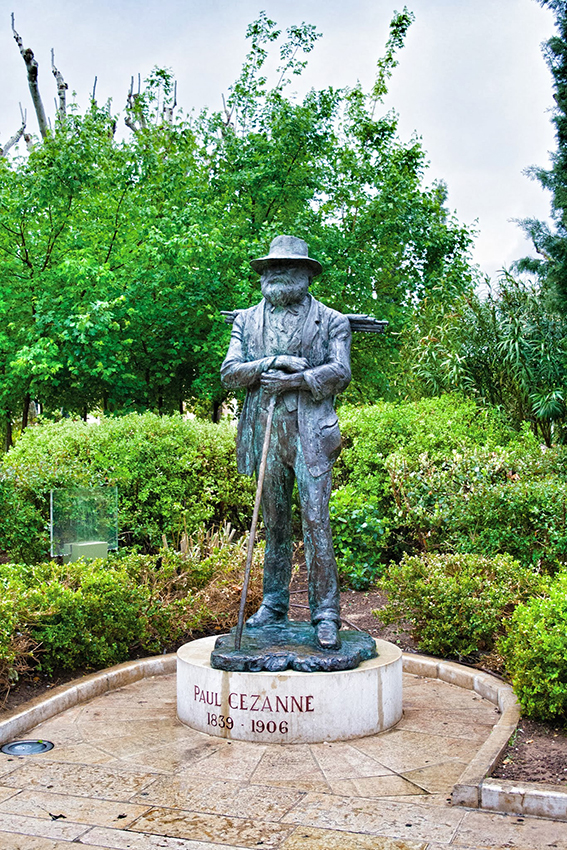
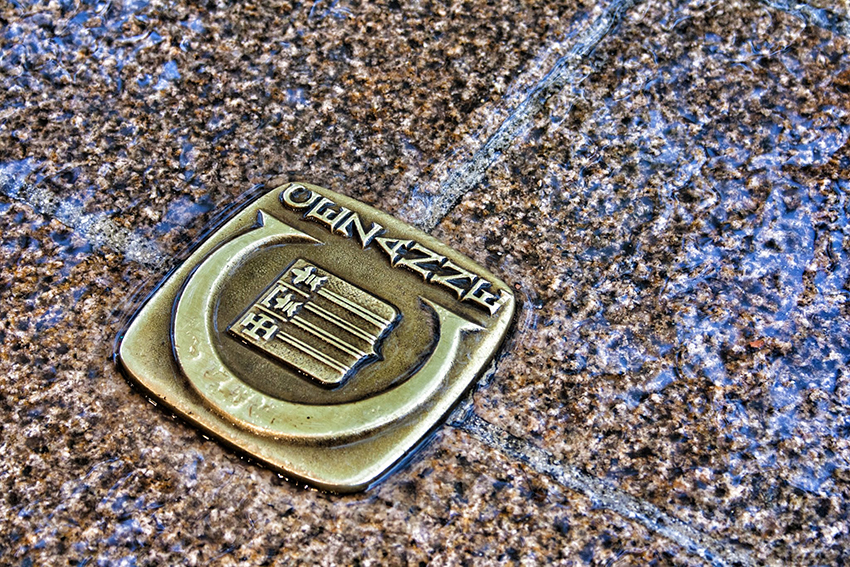
Splashing through puddles my feet became more and more soggy as I became more and more engrossed in what I was seeing than where my feet were stepping. By now the rain was dripping off my hood and past my eyes, so I sheltered under a tree for a couple of minutes. The vivid colours of a nearby fruit stall caught my eye, standing out against its grey surroundings as brightly as the fruit in one of Cézanne’s still life paintings. To my left, the warm light of the boulangerie looked extremely inviting – the seductive smells coming from the place and the food I could see through the window reminded me it was almost lunch time.
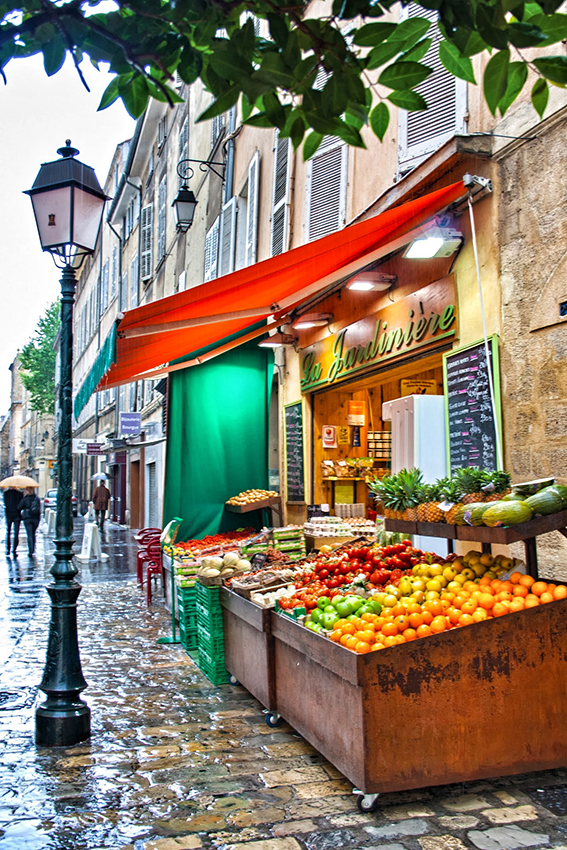
By the time I’d refuelled it had stopped raining – just in time for our departure from the city. The huge curtain of grey sky was drawing back, making way for a canvas of bright blue dotted with fluffy white clouds. I headed back along Cours Mirabeau, once again past its splashing fountains and towering sycamore trees, and the bar that no doubt held so many interesting stories from its past visitors. It was time to say ‘au revoir’ to Cézanne’s hometown.
Want to know more about Leger’s Highlights of Provence and the Dordogne tour? Click here.
Have you visited Aix en Provence? Share your stories and comments with us.
Florence: artistic treasures, amazing architecture and a rapidly-melting
The final city visit on our tour of the Italian Riviera, Tuscany and Rome was the Renaissance city of Florence, a city that was mentioned quite a bit in my art history lessons.
It was a warm and sunny day as we travelled into Florence, or Firenze as it’s known locally, heading firstly to a viewpoint high above the city. Florence sits in the valley of the River Arno and is surrounded by hills and mountains, and it was from the hilltop location of Piazzale Michelangelo that we were given an excellent view over the whole city with the rich terracotta dome of the cathedral’s mighty Duomo dominating the panorama. This is the shot that appears on many postcards so it’s the one to take for your album! Below us the River Arno ran past the pastel-coloured buildings and under the famous Ponte Vecchio which we could see over to the left.
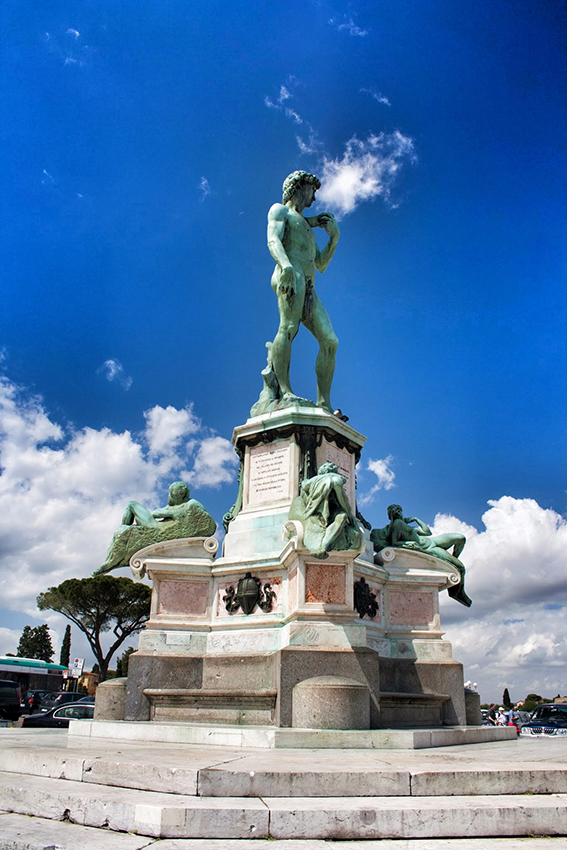
At Piazzale Michelangelo, along with many people taking photos and posing for pictures for their album, there was a replica of Michelangelo’s statue of David, one of the masterpieces of Renaissance sculpture. Apart from that, the square itself wasn’t much to look at – but we were there for the view and that was incredible! Once everyone had the photographs they wanted we headed down towards the centre to meet our guide who would introduce us to her city.
Florence was once surrounded by high defensive walls and towers, and the Tower of the Mint, (Torre della Zecca) which we walked past on our way into the city was part of those walls. This tower was once connected to a string of buildings which were powered by water, and one of these was the Florence Mint (Zecca fiorentina) where the city’s golden florins were made.
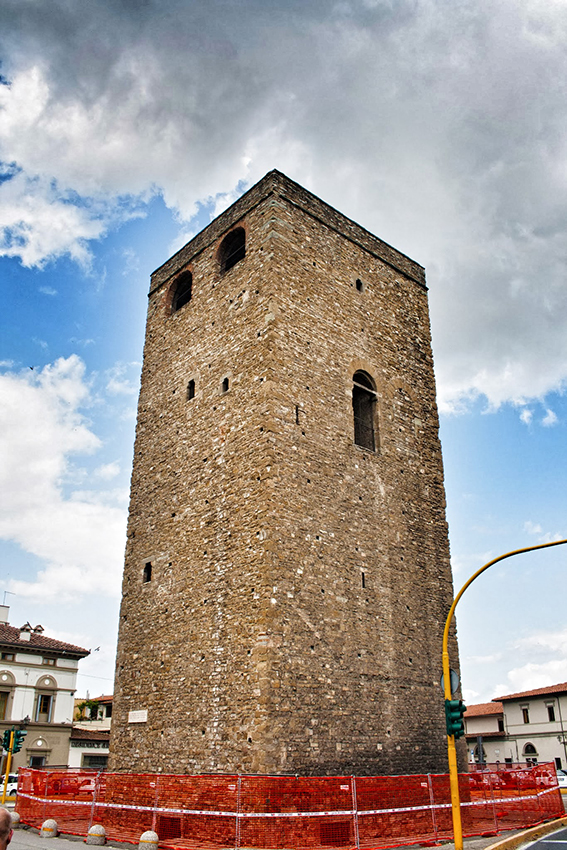
Our guide led us past the Mint Tower and along Via dei Malcontenti, a narrow street sandwiched between cream-coloured buildings. This was apparently the road that criminals were led along to the public gallows, and so it was given the name Malcontenti – ‘malcontent’ meaning unhappy.
After a while, after passing the Franciscan church of Santa Croce with its grand marble façade and weaving our way through the narrow streets of the city, we came out at the Piazza della Signoria, dominated by the huge bell tower; the belfry of the Palazzo Vecchio (Old Palace). This is the city hall of Florence and it was in front of the building that I spotted another reproduction of Michelangelo’s David, the most famous statue on the square. The real one, created in 1504, used to stand here but it was removed and placed in the Accademia di Belle Arti Firenze.
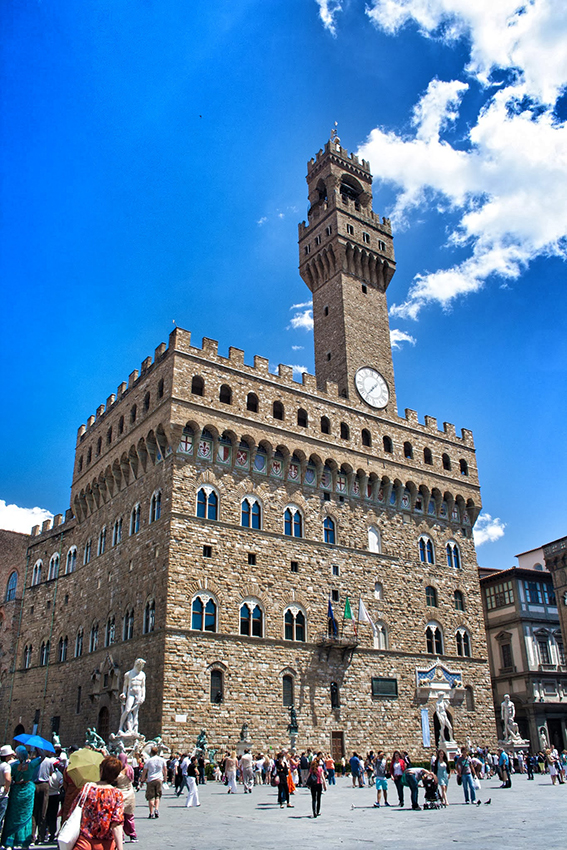
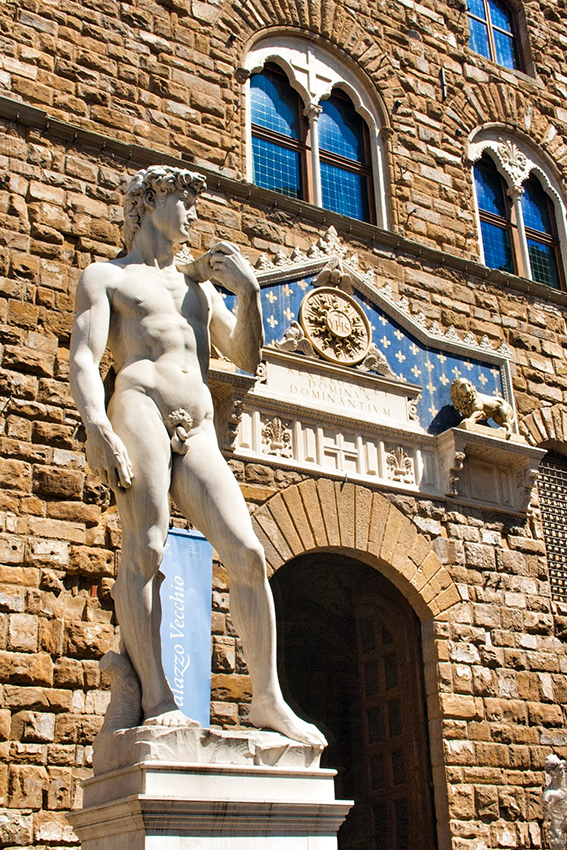
The square was buzzing with a great atmosphere – apparently it’s one of the most popular meeting spots for locals and tourists alike. Across from the city hall was the contrasting sight of designer stores being browsed by well-dressed shoppers and people strolling around trying to eat their colourful ‘gelato’ before it melted in the warm sunshine. Being a girl who doesn’t like shopping (yes, weird, I know!) I opted instead to join the gelato speed-eaters.
Frantically trying to keep the ice cream in its cone, I walked over to the large equestrian statue of Cosimo I de’ Medici standing just beside the city hall. Cosimo was famous for, amongst other things, the creation of the Uffizi which adjoins the Palazzo Vecchio and is now one of the most famous museums in the world, housing one of the greatest collations of art – most of it from the Renaissance period. Works by some of the greatest Italian artists are held here: names such as Michelangelo, Leonardo da Vinci, Botticelli and Giotto, again, names I remembered from the A-Level art classes of my school days. This was one place I would’ve loved to visit to bring to life all those paintings I’d studied in my text books… to see early works by Giotto; Botticelli’s Birth of Venus and Caravaggio’s Bacchus; all images I still remember. But it was time to move on.
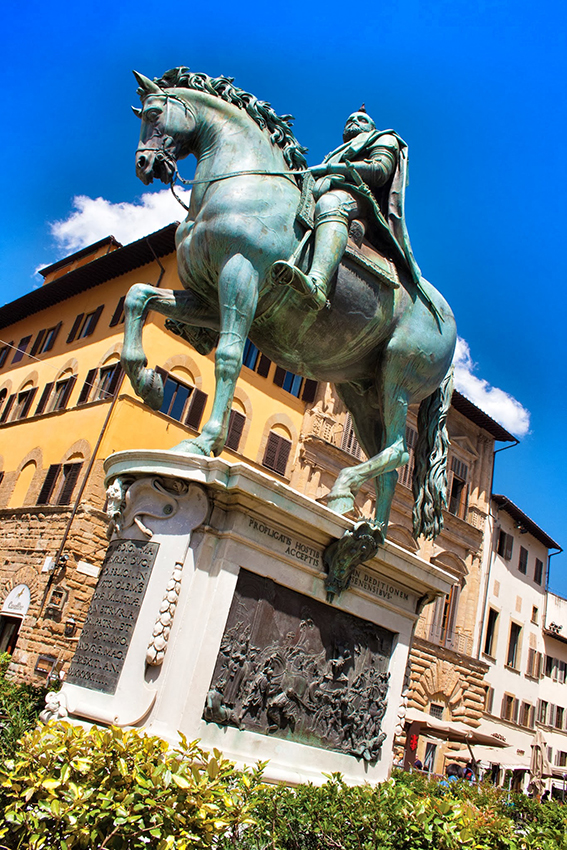
Our guide escorted us along the busy pedestrian street of Via die Calzaiuoli, home to many designer and high street names, a pizzeria here and there and quite a few places to buy those all important ice creams. The sweet smell of crepes and waffles led us along the alleyway until it opened up to reveal the breathtaking Piazza del Duomo. A couple of hours earlier we’d seen the huge domed roof of the Cathedral of Santa Maria del Fiore from the hillside across the river. Now we were up close, and it was truly magnificent.
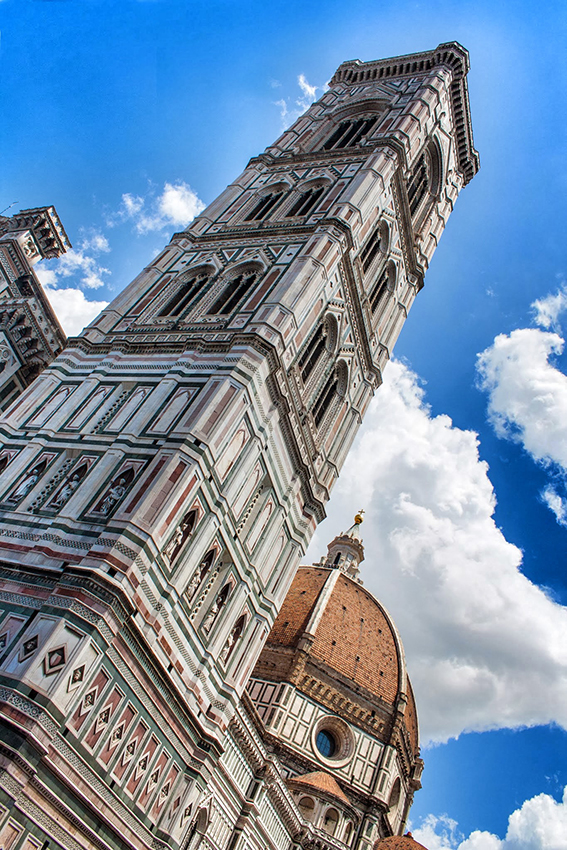
Right in front of us was the huge structure of Giotto’s Bell Tower. The column stands at almost 300 feet high and amongst its green, pink and white marble and displays intricate scenes. At the top, our guide advised us, the tower has 7 bells. We decided not to join the queues waiting to climb the 400+ steps to the top for a closer look and instead took her word for it.
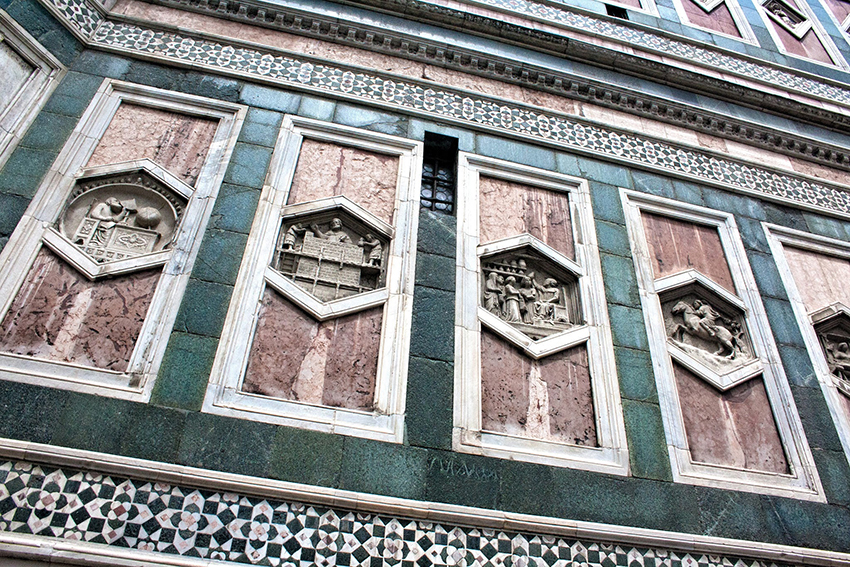
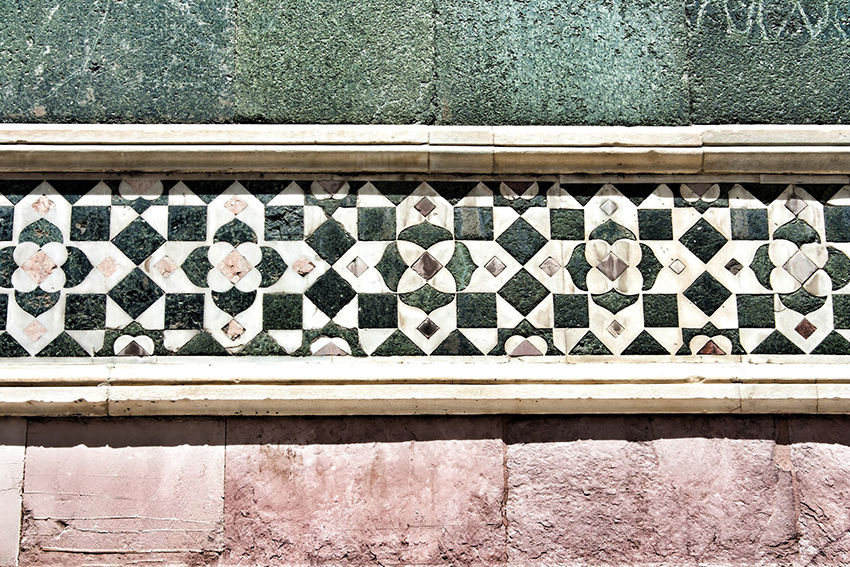
The Dome itself, designed and built by Filippo Brunelleschi, is equally impressive. More than 600 years after it was constructed the ‘Duomo’, as it’s known, still remains the tallest building in Florence. The cathedral is also the 4th largest in the world – the first is St. Peter’s in Rome, the second, St. Paul’s in London and the third, Milan’s Duomo.
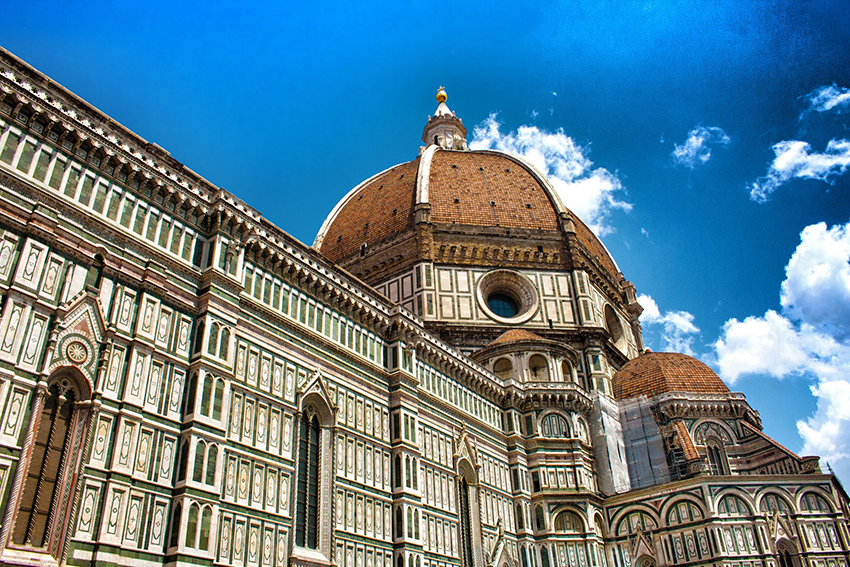
A short walk through the network of bustling passageways took us to the oldest bridge in Florence, the Ponte Vecchio. I’d seen photos of this bridge spanning the River Arno and always thought it looked rather plain, so I wanted to visit it for myself and find out why this well-known landmark is so popular.
The Ponte Vecchio was once the only bridge across the River Arno and the only bridge in Florence that wasn’t destroyed by Germans during WWII. Since the 13th century there have been shops on the bridge. Originally they housed fishmongers, greengrocers, butchers and tanners – the waste from which created a rather unpleasant smell in the river, so much so that in 1593 it was ordered that only jewellers and goldsmiths would be allowed to have shops on the Ponte Vecchio, making the bridge a much cleaner and attractive place to visit. Today, the bridge is still lined with jewellery stores attracting hundreds – probably thousands – of visitors each year.
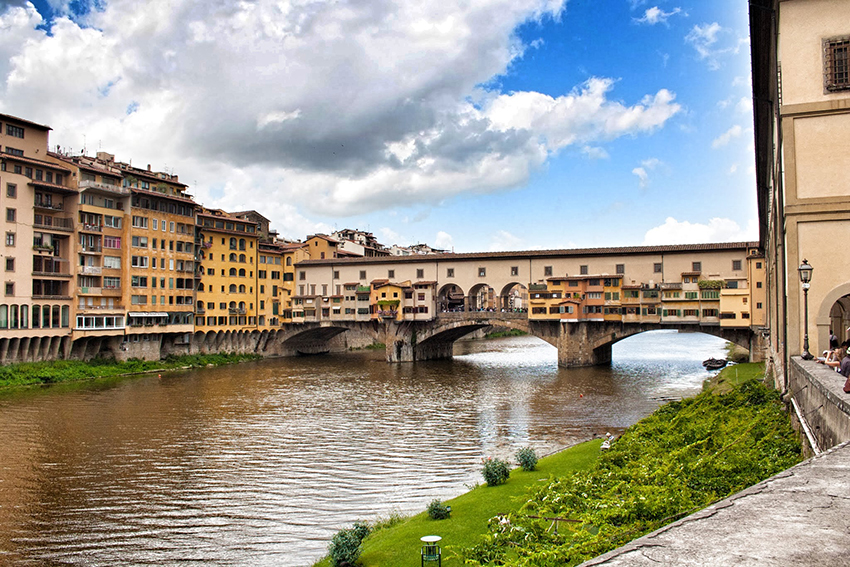
Approaching the bridge I saw the familiar sight of the construction and, even ‘in the flesh’, it struck me how ordinary it looked – a jumble of mustard and reddy-coloured buildings which looked as if they’d been stuck onto the main structure. As I got closer I could see just how ramshackle it appeared. Once on the bridge, however, it was a different story. The place had a great atmosphere and was brought to life by the crowds of people gathered around the stalls and the wares of the gold and silver smiths which twinkled in contrast to the dilapidated appearance of the bridge’s exterior.
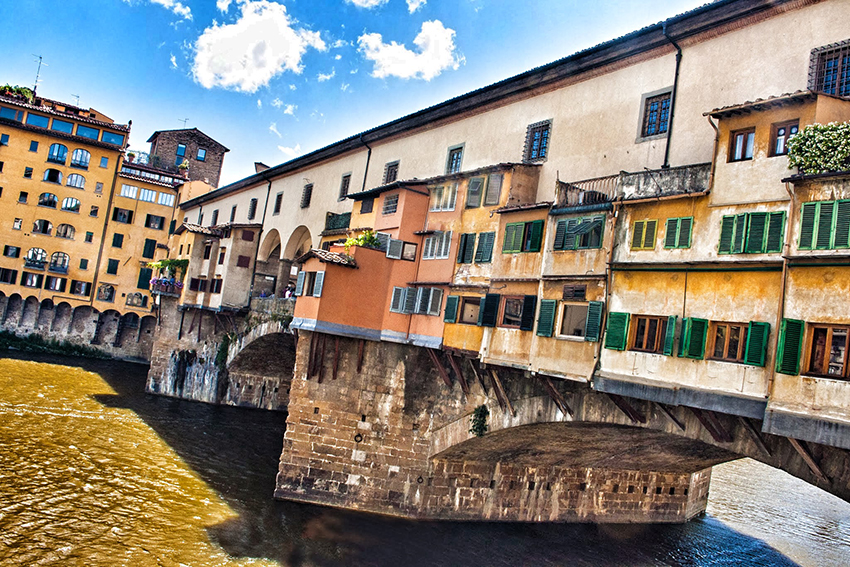
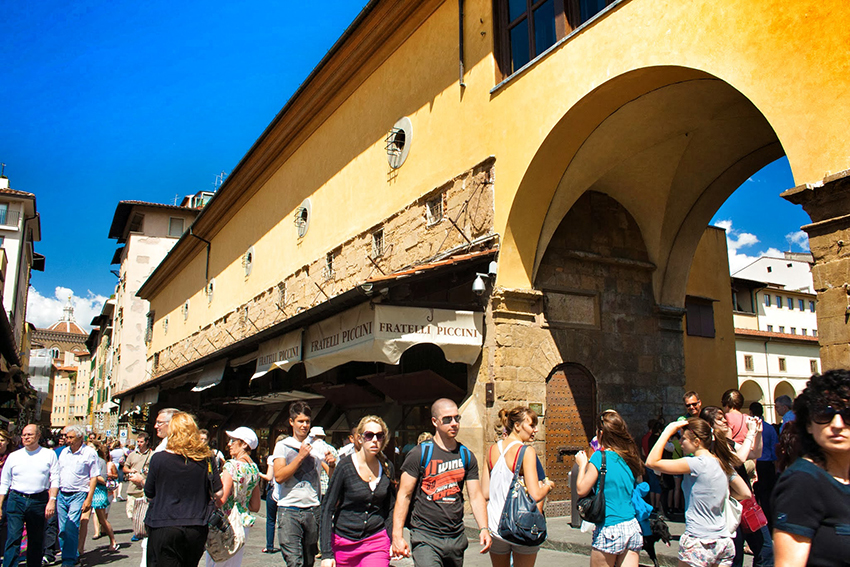
So, I can now say that I’ve visited Florence’s oldest bridge. It hadn’t contradicted my view of it as a rather plain and uninspiring landmark and I think there are much more impressive places to visit in the city, but I’d seen it for myself. The visit to Florence had given me a good overview of the capital of Tuscany, a brief history of the city and some of its landmarks, and of the sights I’d like to return to – namely the Uffizi Gallery.
Leaving the Ponte Vecchio and walking back along the Arno river, our visit to the Renaissance city had come to an end; another place to tick off my ‘must visit’ list… and another place I’d have to return to, one day.
Have you been to Florence? Share your stories and comments with us here!
If at first you don’t succeed…: a dance cut short ' sur le Pont d’ Avignon ’.
Passing through neat rows of grapevines and rolling green fields stretching as far as the eye could see, we continued with our tour of Provence and the Dordogne on our way to the charming walled city of Avignon.
It was a beautiful April morning and the sun was shining as we continued along twisting roads and past the terracotta rooftops of delightful little villages along the way.
Arriving in Avignon we soon had excellent views of the mighty Palais des Papes – the Popes’ Palace – the largest Gothic palace in Europe, and the famous bridge: Pont d’Avignon, Saint Bénezet or ‘the broken bridge’ as it’s also known. Built in the 12th century, this bridge is the subject of a children’s song Sur le Pont d’Avignon, about handsome gentlemen, pretty dames, gardeners, dressmakers, grape growers and various other people all dancing on the bridge of Avignon. In reality, the bridge is only about 4 metres wide, so not a great deal of space for dancing!
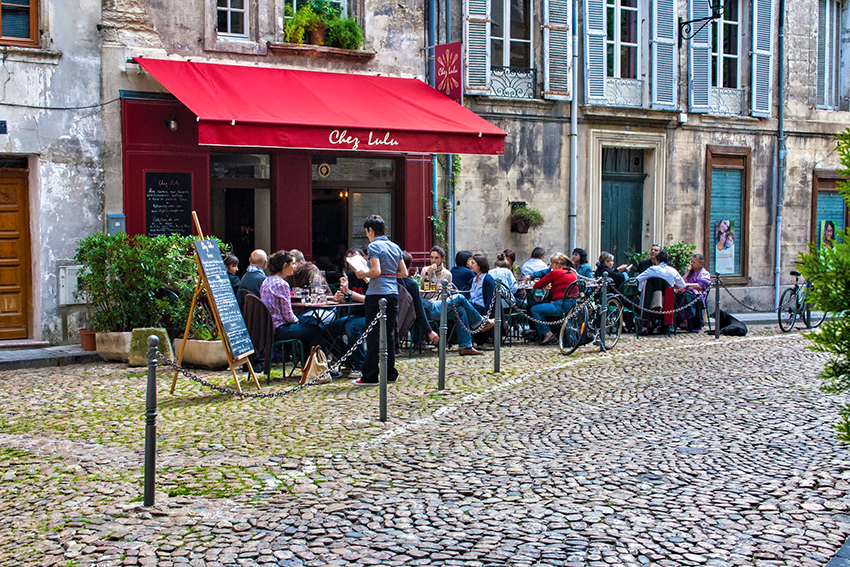
We made our way through the charming streets to the Place du Palais – the second of two main squares in Avignon, dominated by the huge palace which was home to Roman Catholic popes for almost 70 years during the 14th century. Climbing the stone steps we entered the palace for an audio tour around the enormous building with its grand halls, manicured lawn and spacious courtyards. The climb up to the roof terrace was well worth the effort – the reward was an excellent view over the city, the river and the famous broken bridge.
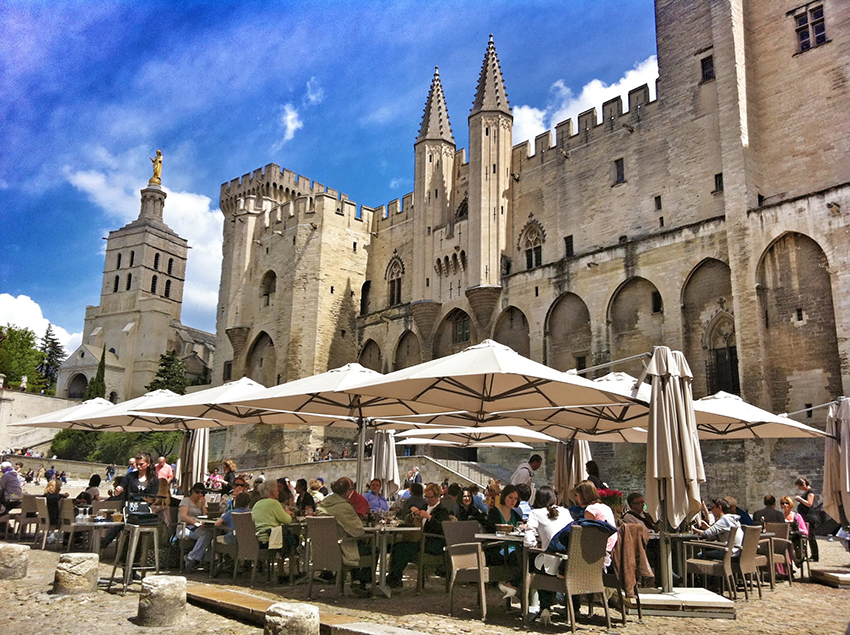
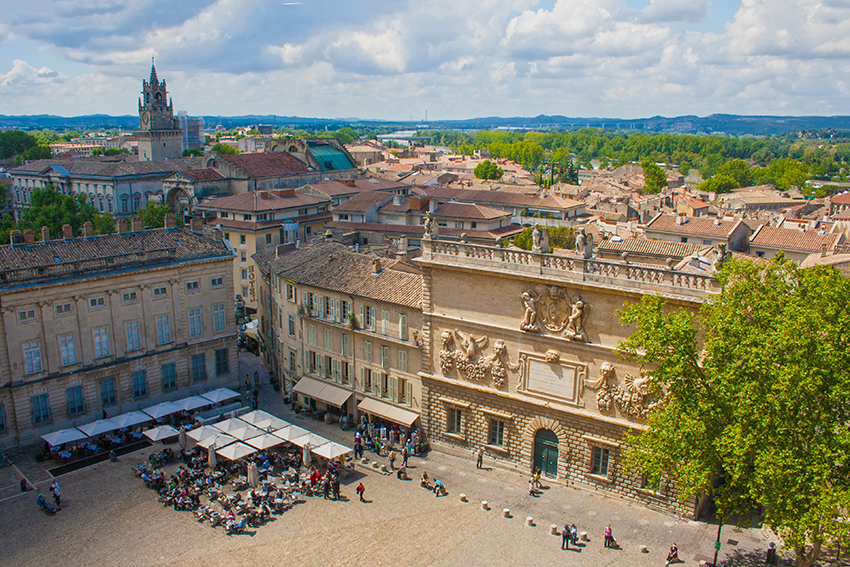
For many years the Pont d’Avignon was the only stone bridge along the 186 mile stretch of the river Rhône between Lyon and the Mediterranean sea. Over the years the structure was damaged and many of its original 22 arches were swept away by the choppy flood waters of the Rhône. The crumbling bridge had to be constantly repaired until the 17th century when the cost of rebuilding and continual maintenance became too much for the city of Avignon to bear and the bridge gradually weakened. In time, the surviving arches collapsed leaving the four that remain today.
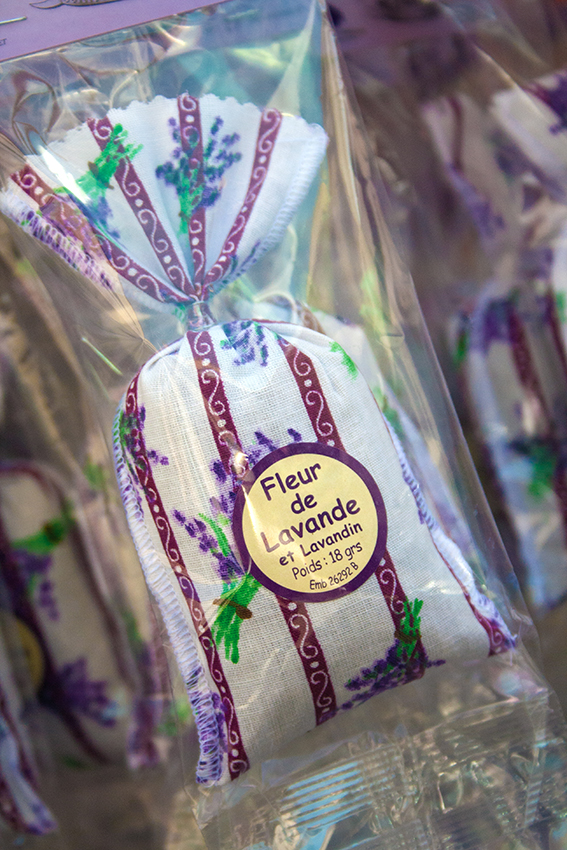
After our palace tour we walked through the city’s tangle of narrow cobbled backstreets, past souvenir shops emitting the sweet smell of lavender from the pretty little bags swinging from displays and out onto the road which runs alongside the Rive Rhône. The oatmeal-coloured stone stood out brightly against the brilliant blue sky as we crossed over the road to get to the medieval bridge. Climbing the steps I could see that the bridge was quite busy with visitors, maybe some of them dressmakers and grape growers wanting to dance ‘sur le Pont d’Avignon’?
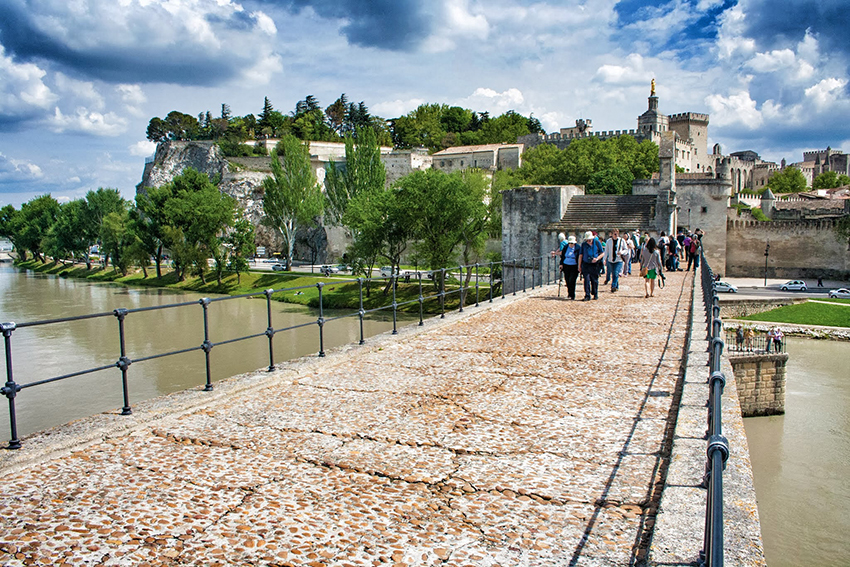
I quickstepped my way through the crowd, desperate to get all the way over to the other side, since it was the view from the banking on the other side of the river that I’d seen all the postcards and in brochures and wanted to capture for myself. Faster and faster I tried to weave through the crowd, camera at the ready. After a few ‘excusez-moi’s, I emerged from the throng of people… and realised… I was trying to cross ‘the broken bridge’.
It was just half an hour until our coach would be departing, but not one to be defeated I did a quick about-turn back through the crowds and with a few more ‘excusez moi’s, rushed back down the steps, along the river bank to the next bridge, over the bridge and down the other side of the Rhône. Walking as fast as my legs would carry me, I jumped over the extended rods of fishermen sitting on the river bank, breaking into a run through a large group of pigeons being fed by families – causing the birds to scatter in all directions – and locals taking their dogs for a leisurely walk.
Back over the bridge at an even quicker pace, I made it back to the coach with time to spare and collapsed into my seat, out of breath, but happy that I’d got the shot I wanted.
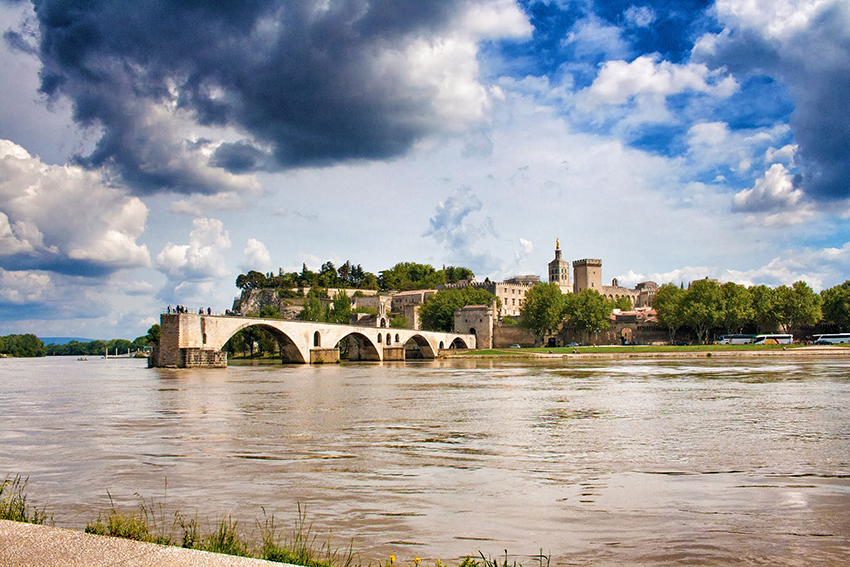
Have you been to Avignon? Share your stories and comments with us! We’d love to hear from you!
KorÄula: Marco Polo’s island… or is it?
It was 8.30am and already a very warm 30º as we left our hotel heading to the island of KorÄula (pronounced ‘Korchula’).
It was day seven of our Dubrovnik and the Dalmatian Coast tour, and we were heading along the winding coastal road. The rising sun was glistening on the water of Gruž (‘groosh’) harbour as we continued along the Croatian mainland and the peninsula of PeljeÅ¡ac, the second largest in Croatia. This beautiful unspoilt peninsula runs parallel to the Dalmatian coast, separating the island of KorÄula from the mainland. The main business in this area, our guide Tangra told us, is tourism, plus red wine, grape growing, mussels and oysters, pointing out the oyster farm in the bay with hundreds of containers bobbing on the ink-blue water. The dry stone walling we passed is the landmark of agricultural land, built with carefully selected interlocking stones, some 150, 200 and even 400 years old. Our journey took us through bright green vineyards and past twisted olive trees – the area also being a producer of good quality olive oil – and very pretty (and very toxic) oleander, a common sight around these parts.
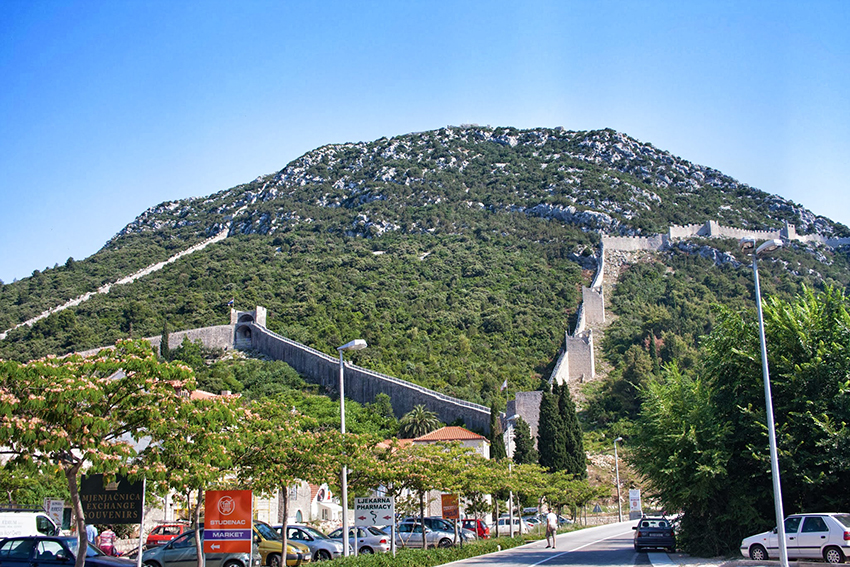
On our way to KorÄula we called in at the historic town of Ston, whose landmark is the 5.5km long stone wall built in the 14th century. This wall, which is open to the public, is thought to be the longest defensive wall in Europe and second longest in the world after the Great Wall of China. If you have the energy, you can walk from Ston to its small sister town, Mali Ston (Small Ston) and enjoy breathtaking views of the charming towns and picturesque coastline. For us however, it was a just a short visit, with just enough time to wander around the smooth cobbled streets and grab a refreshing drink before continuing on to KorÄula.
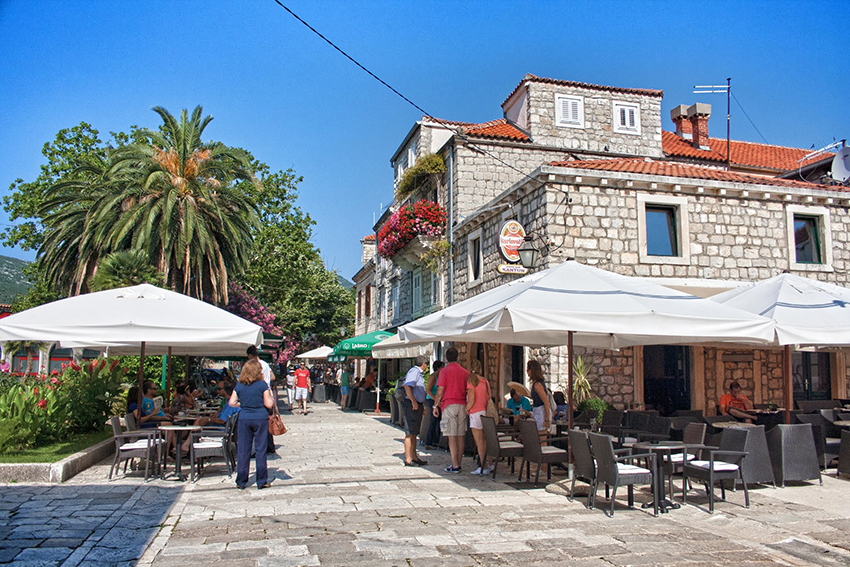
After a cooling 15-minute ferry ride across the turquoise Adriatic Sea, we arrive on the western side of the Old Town peninsula of KorÄula, founded at the beginning of the 13th century, and were met by our local guide, Lea. Dressed head to toe in white linen and with rich copper-coloured hair cut into a choppy bob, Lea was extremely tall – as are many people around this area, her pale face brightened by a flash of deep red lipstick. She told us how excited she was to be using her brand new parasol – apparently she’d been waiting for it for a long time! I could see how it would be such a welcome piece of apparatus if you were walking around in this heat each day.
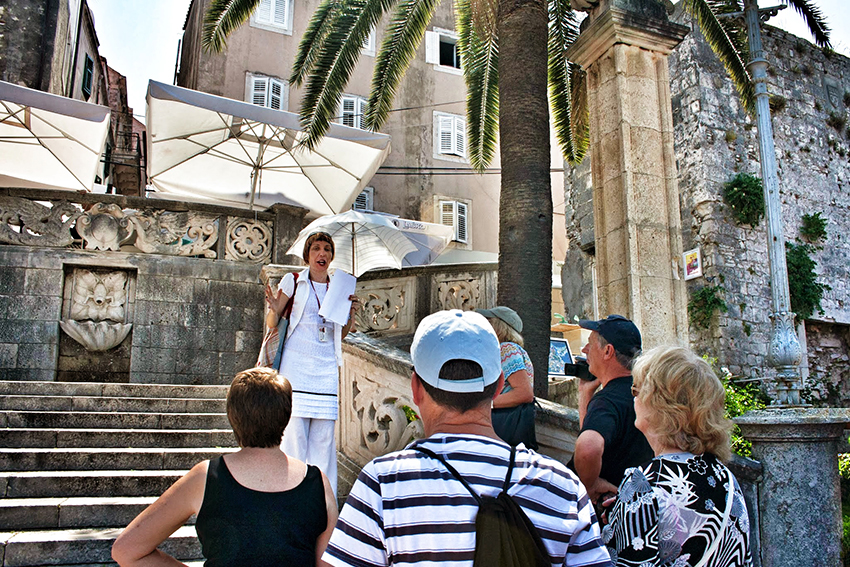
The town is surrounded by thick stone walls dating from the 14th century and towers that were built in medieval times to defend against enemies passing the island. 12 towers once stood on the island, today, just seven remain. Leading us up the stairway which took us through the entrance known as Sea Gate and one of the towers, called Kula Morska Vrata, Lea pointed out the view to the western part of KorÄula Town famous for its sunsets as the sun dips between the peninsula and the rest of the island. Entering the Old Town we walked along the narrow stone streets of the peninsula which gave us a welcome shelter from the heat of the day.
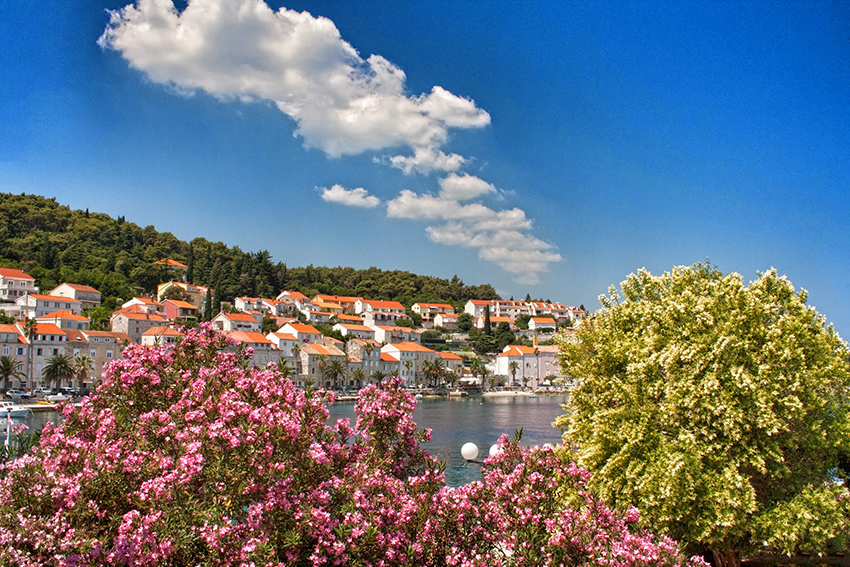
The Old Town of KorÄula itself has an interesting layout, almost like the bones of a fish. There’s a long main street running right through the centre of the town with smaller alleyways fanning out to either side. To the north west the streets are straight allowing the summer breeze known as the ‘maestral’ to come in from the sea, cooling the streets in the hot months. In winter comes the cold wind from the east, the ‘bura’, sometimes so strong that roads are closed as a precaution. On the south-eastern side of the peninsula the streets are more curved, reducing the effect of the bura blowing through. On the day of our visit, there was a pleasant light wind – maybe this was the maestral in action?
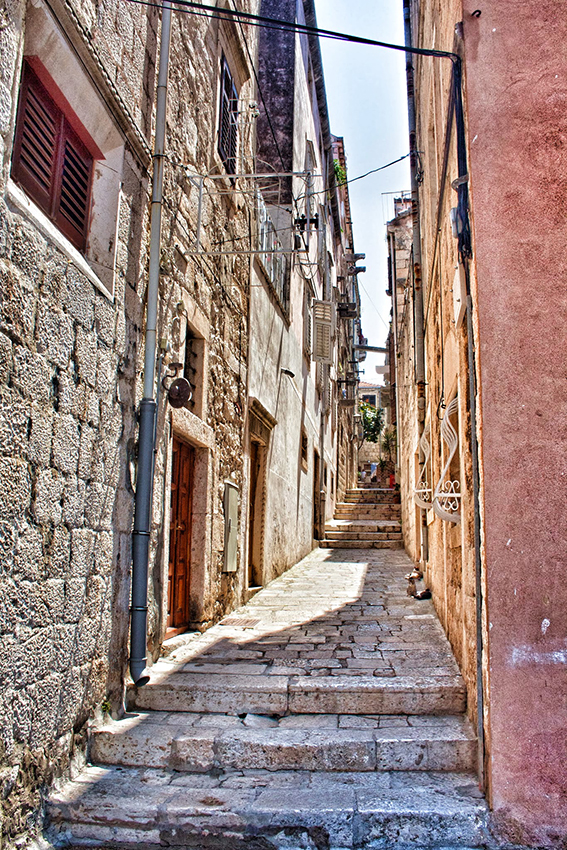
As we walked through the criss-crossed narrow alleyways Lea pointed out the bridges connecting buildings on the opposite sides of the street. These ‘bridge balconies’ joined the houses of close families for easy access, enabling them to cross over the balcony instead of going through the street.
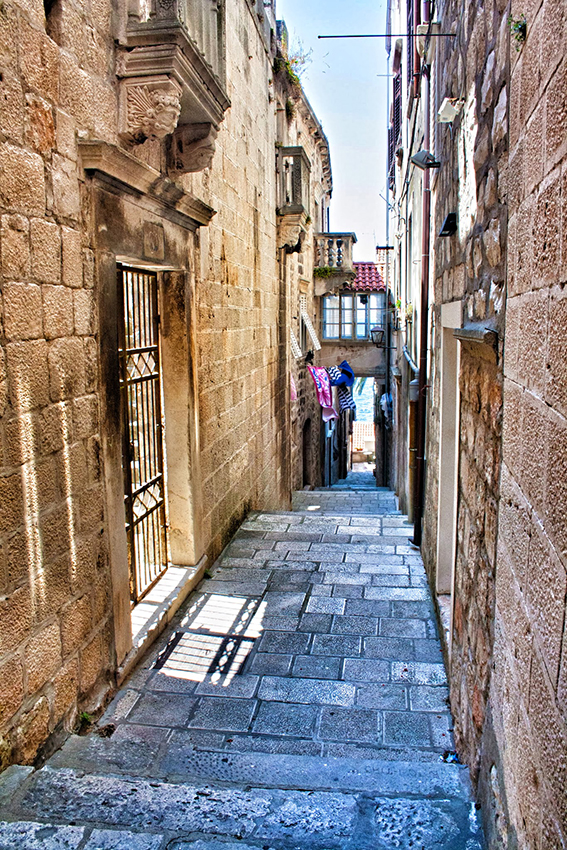
Our tour continued past a giant 25-year-old rubber tree, the largest on the island, through winding streets with the mouth-watering smell of savoury food being carried along on the breeze. The smooth cobbled streets were quiet as Lea guided us along to the museum and on towards the 15th century St. Mark’s church right in the centre of the town.
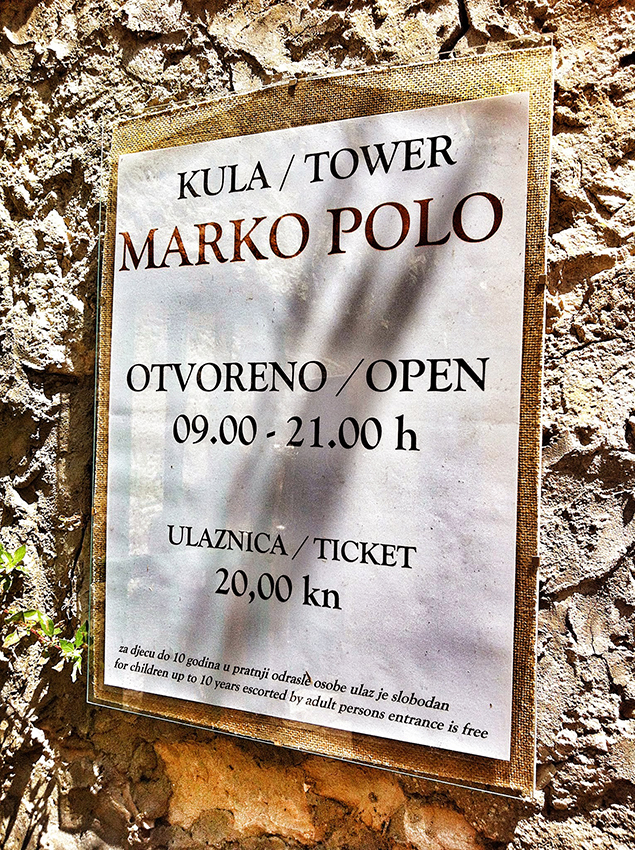
It was here that our tour came to an end. As we said goodbye to Lea, I continued the short stroll on to what is believed to be the house in which Marco Polo was born. The sweet smell of lavender from the pots which lined the wall hit me as I entered the stone doorway and climbed the narrow stairs of the tower or ‘loggia’, to be met by wonderful views over the town and out to sea. It has been argued by some that the explorer and writer was born in Venice and also Curzola off the coast of Dalmatia, but whether this lovely stone building in the centre of KorÄula was Polo’s birthplace or not, it was a lovely little place to call into.
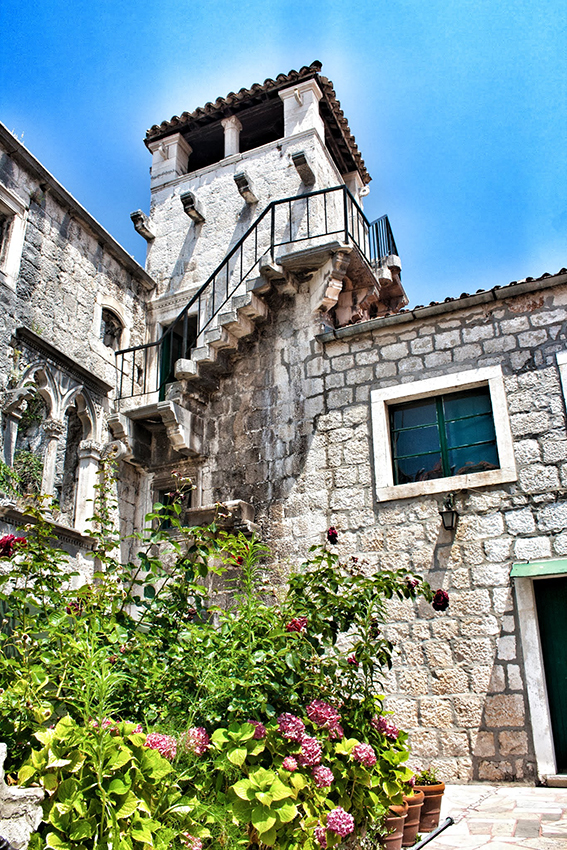
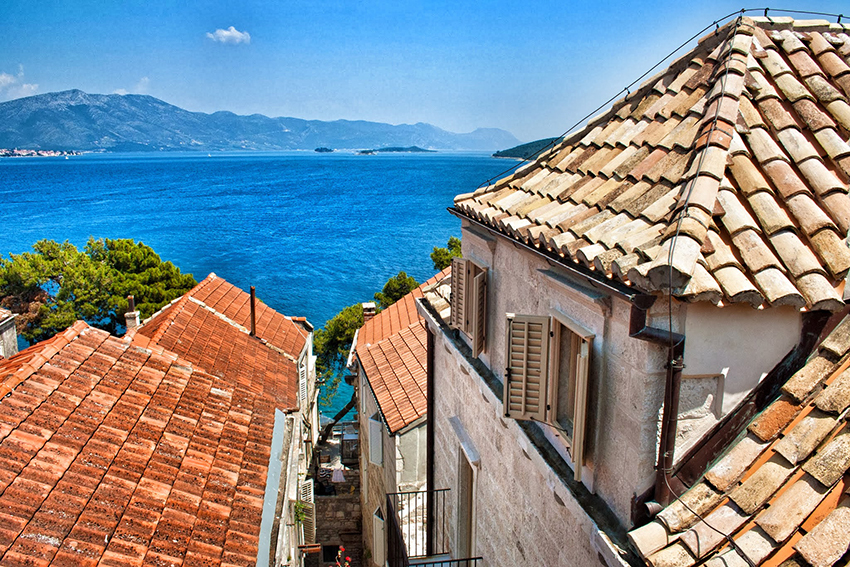
The peninsula is a really pleasant place to wander around: I passed little galleries and craft shops tucked into stone buildings, walked beneath washing hung out to dry across the ornate wrought iron balconies, and busy restaurants with brightly coloured umbrellas fluttering in the breeze. There were plenty of places to eat offering everything from sandwiches to pizza, pasta and seafood – it all smelled delicious! Continuing my explorations of the peninsula, I strolled through the backstreets which lead to the eastern side, lined with more inviting restaurants where people were enjoying a spot of lunch whilst taking in the fantastic views out across the sparkling sea. There was a lovely breeze, and the smell of seafood and wood burning stoves wafted along as I continued north, arriving at Zakerjan Tower (Kula Zakerjan), also called Berim Tower, then back along the main street running through the centre of the peninsula to the Land Gate or Revelin Tower (Veliki Revelin) at the south, built in the 14th century.
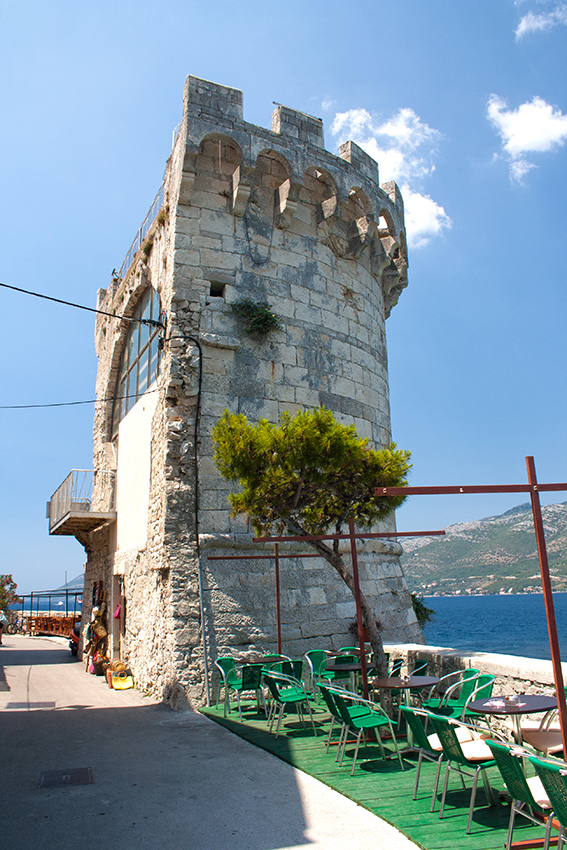
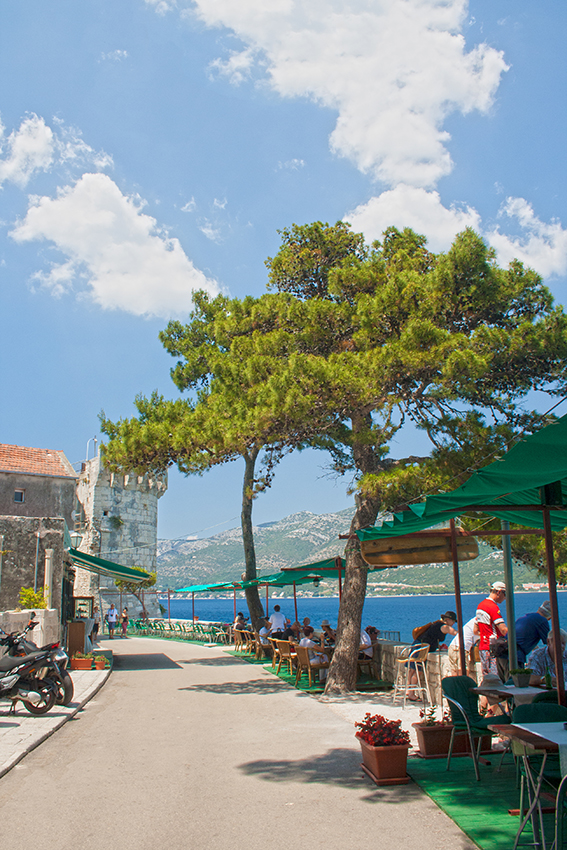
The original wooden drawbridge which stood at the Land Gate was replaced in the 18th century by the sweeping cream stone steps which stand there today. As I made my way down the grand staircase I was met by the lively atmosphere of colourful market stalls selling stones, jewellery, t-shirts, hats and souvenirs and with people hunting for a bargain.

Palm trees rustled in the breeze as I made my way around to our meeting point. It was time to say goodbye to the island of KorÄula after a wonderful few hours on this charming peninsula and a day of stunning scenery, beautiful Croatian sunshine and stories of Marco Polo.

Have you visited KorÄula? Share your stories with us!
Art, architecture and tree-lined avenues: see the sights of Paris in a day
It was a warm early autumn morning, and I’d just jumped out of a taxi at one of the most famous landmarks in Paris, the Arc de Triomphe. There were people chatting, others posing for photos, cars, buses and scooters whizzing around like the horses on a merry-go-round and high above us, people walking around the top of the structure, which looked so much larger up close than it appeared in any of the photos in the brochures.
I’d chosen to spend a full day in Paris – the third day of my four-day coach break – and see the sights on foot. I’d joined the guided sightseeing tour by coach the day before which gave me a good idea of where things were and decided that I’d get out amongst the hustle and bustle of the streets of the wonderful French capital. Whenever I go away, I prefer to walk around (whenever possible) – I get to see more and sometimes end up in places I didn’t intend.
So, armed with my already-crinkled city map, I was there: at the top of the Champs Elysées, on a hot September morning with the whole day ahead of me.
As I strolled along past small souvenir shops and large stores displaying designer names, the morning sunshine was glittering through the trees lining the famous avenue. There were people in cafés chatting on mobile phones or with friends, enjoying a croissant and ‘cafe au lait’. Smartly dressed ladies with large sunglasses hurried past, phone in one hand and a glossy, rigid designer shopping bag on the other arm. I had entered into the world of ‘chic’.
My route took me all the way along the two-kilometre length of the Champs Elysées to one of the best-known squares in Paris: the Place de la Concorde, originally a site of execution during the French Revolution. Here, the splashing of fountains and sound of people chatting and laughing as they posed for photos filled the air, along with squeals as passers-by were taken by surprise by the statues that come to life as soon as you get near them. The scene was so far removed from what I imagine it to have been like in the late 18th century.
Continuing straight across to the Tuileries Gardens – an area which was once a clay quarry for tiles, or ’tuilerie’ – I turned to see the Arc de Triomphe, now a tiny archway in the distance, and the unmistakable structure of the Eiffel Tower over to the left, standing against the bright blue sky.
By now the temperature had risen quite a bit and as I entered the wide lane running through the Tuileries Gardens, linking the Place de la Concorde and the Louvre, there were people sitting around a large fountain on green steel chairs reading, sunbathing, kissing, chatting and listening to music, whilst others relaxed in the cafés under the shade of the horse chestnut trees lining the avenue.
As I walked, the gentle sounds of the cream-coloured gravel crunching underfoot and birds singing above, the quiet hum of conversations and the bells of energetic cyclists ringing as they whizzed past all made for a very laid-back wonderful atmosphere.
Ahead of me was the large building of the Louvre Palace, home to one of the world’s largest museums and the modern glass pyramid which sits in the main courtyard. As I got closer I could see the long queue of people, all waiting to get in to the famous museum for a peek of one of art history’s most famous paintings, Leonardo’s Mona Lisa, perhaps or maybe the elegant sculpture of Venus de Milo?
By this time it was extremely hot, with people sitting on the edges of the fountain dangling their feet into the water to cool down. I joined them for a few minutes and soaked up the atmosphere of my surroundings: the impressive glass pyramids, the decorated façades of the Louvre Palace; the cooling water pools and the visitors enjoying their day. It gave me a good opportunity to update my notebook, check my camera and consult my map. With my various bags, pockets and pieces of kit to delve into, the moment turned to slow motion as I saw my video camera taking a dive! “Nnnnnooooooo!!!†I yelled, as I lunged to grab it, but it was too late. There was a loud ‘PLOP!’ and there lay the camera, in 2 feet of water like a coin tossed into a fountain by visiting tourists. I reached into the cold water to retrieve the camera – knocking my map into the pond in the process – and left it to dry on the wall, in the hope, somehow, of bringing it back to life! After a few minutes, in the heat of this beautiful September day, the map was functional again, despite being a bit soggy. The video camera, on the other hand, was not.
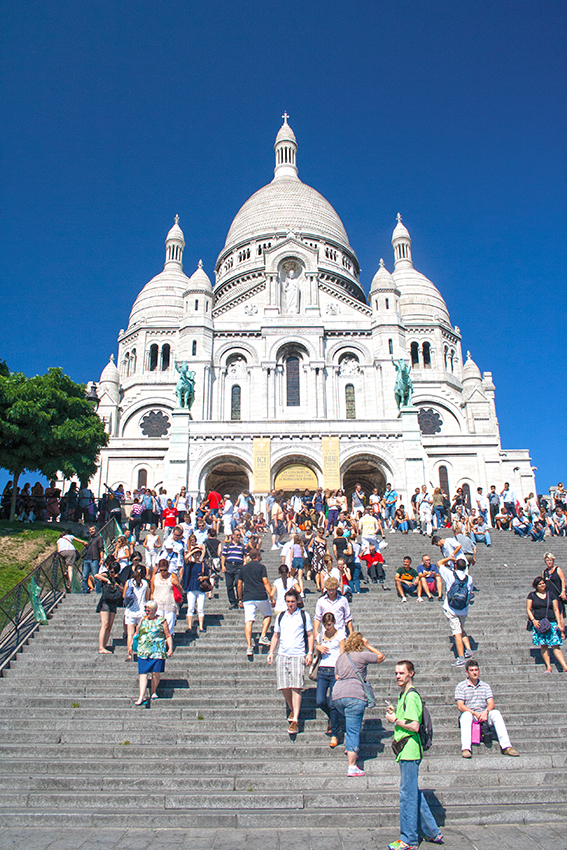
Next on my list of ‘things to see’ was the Sacre Coeur Basilica – the Basilica of the Sacred Heart. Peeling my map apart, I set off through the passage leading out of the Louvre courtyard and along the Rue de Louvre, heading for the Montmartre area. 45 minutes later, after asking a couple of people in shops and bars for directions and after a lot of pointing and hand gestures, I reached the Sacre Coeur. The bright building stood out against the deep blue sky, much larger than I had expected. It had been quite a long walk – especially in the heat – and a lot of it had been up hill, but it was worth it for the wonderful view over the city. As I arrived at the steps I noticed the funicular which takes weary sightseers up the hill to the basilica itself.
After catching my breath, I climbed the steps and followed the road around to the left of the cathedral, heading for the Place du Terte. Taking a left turn at the end of the wall, suddenly the road was really busy. The volume cranked up a notch or two, with music playing and people chatting at the bars and cafés and at the plentiful souvenir shops – there was a real buzz about the place. As I ventured through the crowds of the narrow street and out into a little square, there was an elderly woman singing along to the old music box she was playing, fed by a roll of paper with holes in it. Wearing knee-length denim trousers, a shirt and a neckerchief with a floppy, cap-style hat, the woman was attracting quite a crowd, some of them clapping along to the music while others captured it all on film.
The sun was beating down as I passed the crowds and there in front of me was Place du Tertre. The square, although small, was lined by restaurants on one side and was a maze of artists – an extremely busy place where painters sat at their easels, applying oil paint to their canvas while others were busily sketching as they glanced over their thick-rimmed spectacles every so often to see if their display has any interest. There were traditional paintings and some more modern or abstract; old artists with bushy white beards, some clad head to toe in denim; others wearing neckerchiefs and shoes with no socks – the atmosphere here was wonderful. One old artist stopped mixing the colours of his palette to stand up and show us his works. I noticed he had bright green paint dotted in his wiry white beard. “I have many more – this one is quite good†he told us, showing us another of his colourful works. Behind the artists, shaded restaurants were bustling like the rest of the area, packed with contented customers.
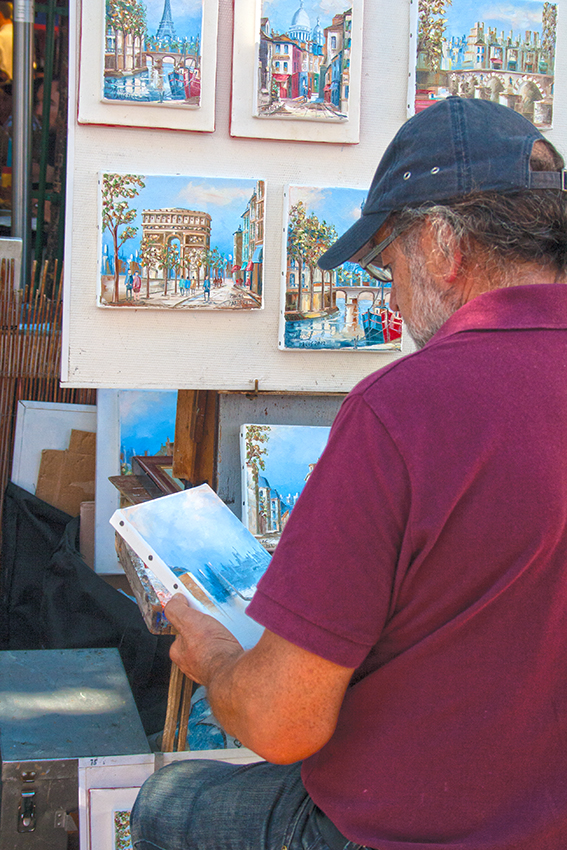
I would’ve loved to spend much more time around Place du Tertre. I could easily have spent a day around the Montmartre area with its inviting and alluring atmosphere, just as I could’ve idled away a few hours watching the world go by from a Parisian café or strolling around the Tuileries Gardens, soaking up the sun and the wonderful atmosphere. I’d seen so much during my day in Paris: the Arc de Triomphe; Champs Elysées; Place de la Concorde; Tuileries Gardens; Eiffel Tower (OK, so this one was from a distance!); the Louvre; the Sacre Coeur; Montmartre and the Place du Tertre… and I know there’s still more for me to see in this magical city. I’ll just have to come back one day!
What’s your favourite part of Paris? Share your stories with us.
New Archeological Excavations – The Juno Beach Centre
New Archeological Excavations At The Juno Beach Centre in Normandy
Planning a visit to Normandy in 2014? Make sure you incorporate a visit to the Juno Beach Centre to explore newly reopened bunkers and tunnels!
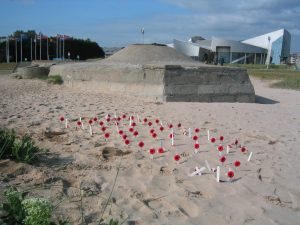
An archaeological dig is currently underway in Juno Park, the area spanning the front of the Juno Beach Centre, which is home to a large stretch of remnants of the German Atlantic Wall fortifications and was a major strong point in the German defence zone between 1942 and 1944. It is estimated that over 30 concrete fortifications are buried in the sand between the Centre and the beach. This system of bunkers, tunnels, ammunition stores, and pillboxes shed a light on the German occupation of Normandy and also tell the story of how the allies, mainly the Canadians, were able to push them back from the wall. The physical traces left by the German Occupation, the construction of the Atlantic Wall and the D-Day Landings make up a cultural heritage worth preserving.
The Juno Beach Centre is thrilled to announce that work is now underway to have a section of these fortifications open to the public and integrated into the guided tours of Juno Park in time for the 70th anniversary commemorations of the Battle of Normandy in 2014.
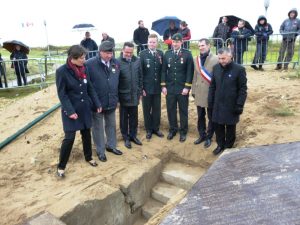
On November 11, 2013, Frédéric Pouille, Mayor of Courseulles-sur-Mer, officially announced the beginning of the works to rehabilitate the underground German Command Post with a groundbreaking ceremony.
It is expected that this work will be completed by April and incorporated into the guided tours of Juno Park. Contact the Juno Beach Centre for more information or visit Leger Holidays Battlefield website to find out which tours include the Juno Beach Centre.
Seen It Live – The German Grand Prix
Zara Thompson, Reservations Supervisor, has worked at Leger for 6 years. Enjoying the races on TV, she wanted to experience the real thing.
My husband and I had our first Grand Prix experience at Hockenheim, Germany in 2012 and had such an amazing time, so decided to go again this year.
Which tour did you go on?
The German Grand Prix 2013 at the Nürburgring.
How did you get there and how long did it take?
We drove to the Holiday Inn at Ashford North the day before and were collected at 1pm by a feeder coach. This was a leisurely start and not too tiring on the first day. The Channel crossing was by ferry from Dover to Calais, during which we had time to relax on board and start to take in the atmosphere of the avid Grand Prix fans all travelling to Germany. We arrived at our hotel around 11pm, which was reasonable for the distance we had travelled to be close to the circuit.
Where did you stay?
We stayed at the 4-star Ramada Hürth-Köln which was in a great location, with places nearby to get our evening meal and only a 1-hour drive from the circuit. After a lovely breakfast, we left the hotel in good time to beat the traffic to get to the Nürburgring.
How does actually seeing it live compare to watching on TV?
It’s such an incredible difference, being at the circuit to watching the race on TV. From the sounds of the roaring engines to the smell of the fuel, you get to feel the intensity of the F1 cars and see just how quick they fly around the track. It’s such a good atmosphere, with all the different supporters of teams, drivers and nationalities. There’s a real sense of camaraderie and mutual respect between each supporter, all together, just there to have a good time and enjoy the race. Before we went, we knew we wouldn’t get to see as much of the race as you do on TV, but the atmosphere more than made up for that. At qualifying, we walked around the circuit to work out the best places to stand to see the race. On the race day we found where we wanted to be and managed to get in front of a screen and saw more or less everything they showed on the TV as well!
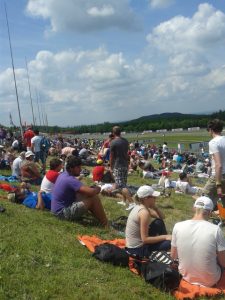
Did you go to watch a certain driver or team?
I will always be patriotic and support McLaren, but this season, I have had to follow my not-so-secret crush: Lewis Hamilton! Kitted out in Mercedes gear with a huge Hamilton flag was a bit daunting in the middle of a crowd of Vettel fans… in Germany! When Lewis got pole position on the Saturday we wanted to discreetly slope away back to the coach… to our surprise, all the German fans were cheering with us and had a few beers with us at the bar!
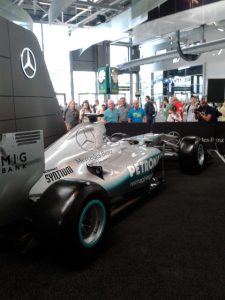
What was the weather like? Did it affect your visit?
As we had this as our main holiday this year, we were really hoping to get some sunshine. The whole weekend was glorious from when we arrived in the morning until after the race ended in the late afternoon. It made the experience more enjoyable and worthwhile, rather being in rainy Silverstone back in the UK!
Please sum up your tour in five words?
Atmospheric, surprising, experience, thrilling, loud!
Would you do a Grand Prix tour again?
Definitely! Nürburgring was top of the list, but I’d love to go to the Belgium Grand Prix and The Monaco Grand Prix.
Discover the latest Grand Prix and F1 holidays here.

